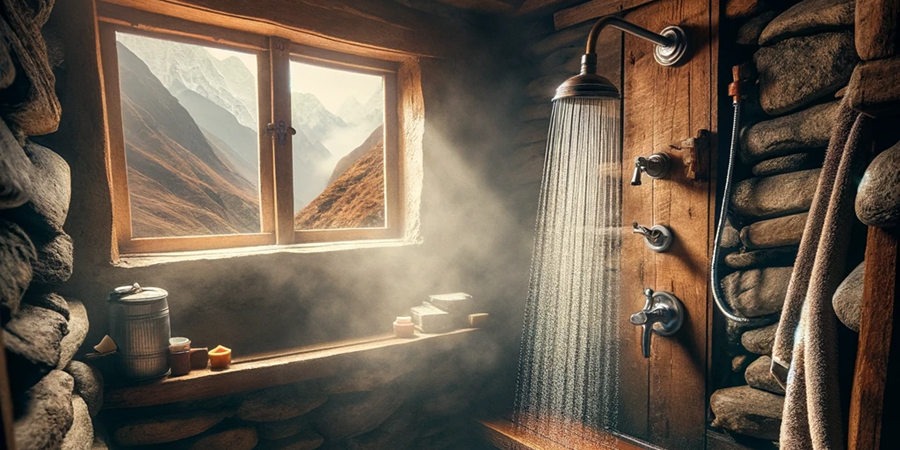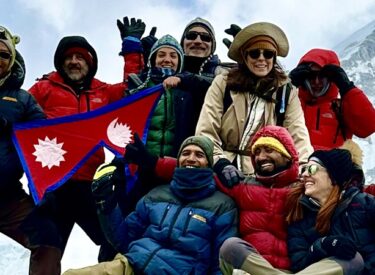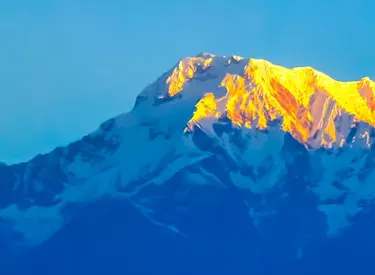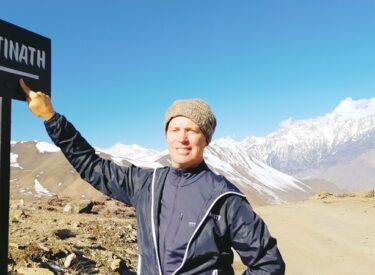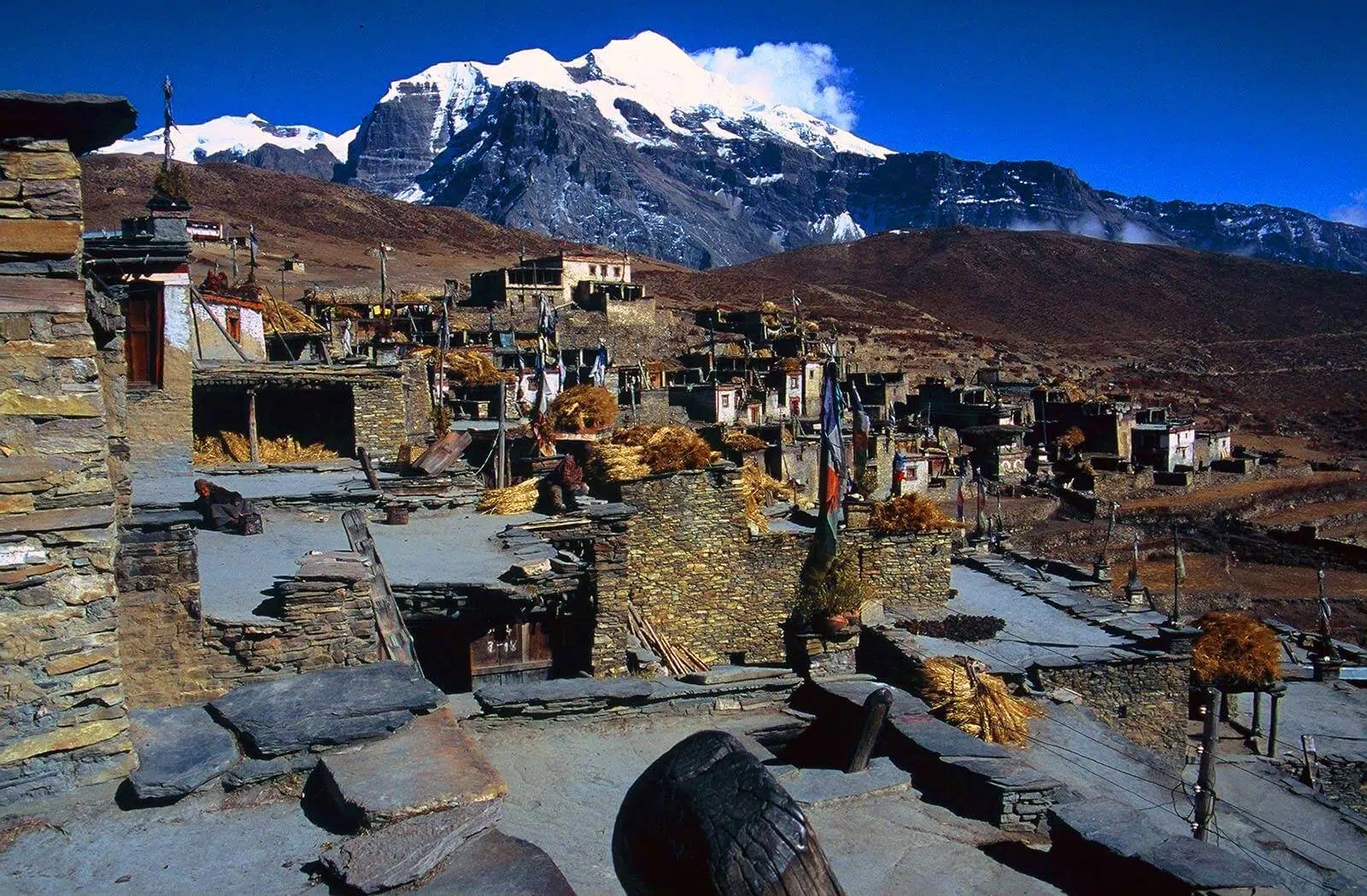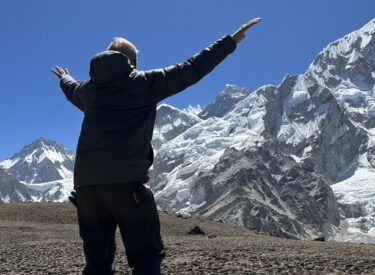Annapurna Base Camp Trek
based on 178 reviewsOverview of Annapurna Base Camp Trek
Discover the allure of the Himalayas on the Annapurna Base Camp Trek, a journey that epitomizes adventure and natural splendour. This trek, a beacon for adventurers worldwide, takes you through Nepal’s heart, showcasing breathtaking landscapes, vibrant cultures, and towering peaks.
As you traverse lush rhododendron forests, charming Gurung villages, and rugged mountain paths, the Annapurna Range is a majestic backdrop, culminating in the awe-inspiring Annapurna Sanctuary. At an altitude of 4,130 meters, the Base Camp offers more than just panoramic views; it’s a testament to human endurance and nature’s grandeur.
Perfect for seasoned trekkers and enthusiastic beginners, this trek blends the thrill of exploration with profound cultural immersion. Join us on the Annapurna Base Camp Trek and experience the pinnacle of Himalayan trekking, where every step is an adventure, and every moment is a memory in the making.
Itinerary of Annapurna Base Camp Trek
Welcome to the exhilarating start of your Annapurna Base Camp Trek! Your journey begins when you land at Kathmandu Airport, where a warm reception and a comfortable transfer to your hotel await you.
This initial day in Kathmandu is pivotal, setting the stage for the incredible trekking experience ahead.
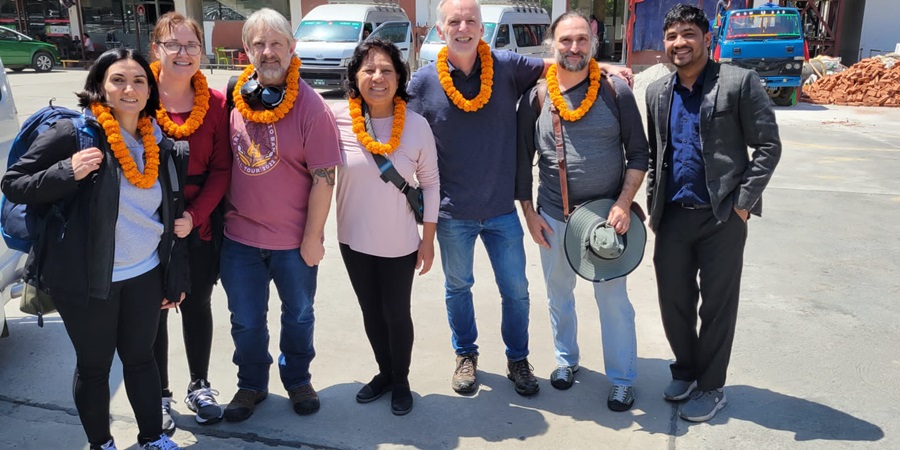
First Day Essentials: Briefing and Preparations
- Comprehensive Trek Briefing: You’ll attend an essential briefing session about the Annapurna Base Camp Trek at your hotel. This meeting is vital to a successful and enjoyable trek.
- Meet Your Guides and Team: Get introduced to your experienced guides who are experts in the terrain and culture of the Annapurna region. They will offer in-depth insights about the trek itinerary, safety protocols, and what makes the Annapurna region unique.
- Interactive Q&A Session: This is the perfect time to ask questions, address concerns, and familiarize yourself with fellow trekkers.
Gear Check and Market Visits
- Gear Review and Purchases: Utilize this day to review your trekking gear. Kathmandu’s vibrant markets are ideal for last-minute purchases, offering a wide range of trekking equipment and supplies.
Cultural Immersion in Kathmandu
- Explore Nepalese Culture: Your first day isn’t just about preparations; it’s an opportunity to dive into Nepal’s rich cultural tapestry. Savour the local cuisine, explore the city’s historical sites and absorb the lively atmosphere of Kathmandu.
- Rest: Ensure you get ample rest in your hotel, rejuvenating yourself for the adventure in the heart of the Himalayas.

This initial day in Kathmandu is a blend of excitement, preparation, and cultural exploration, forming the foundation for an unforgettable trek to the Annapurna Base Camp.
Embrace the start of this journey with enthusiasm and readiness for the extraordinary experiences that await in the Nepalese Himalayas.
Your Annapurna Base Camp Trek adventure begins with a captivating early morning drive from Kathmandu to Pokhara.
This journey, spanning approximately 8-9 hours, is more than just a transfer; it’s a window into the heart of Nepal’s diverse landscapes and the daily lives of its people.
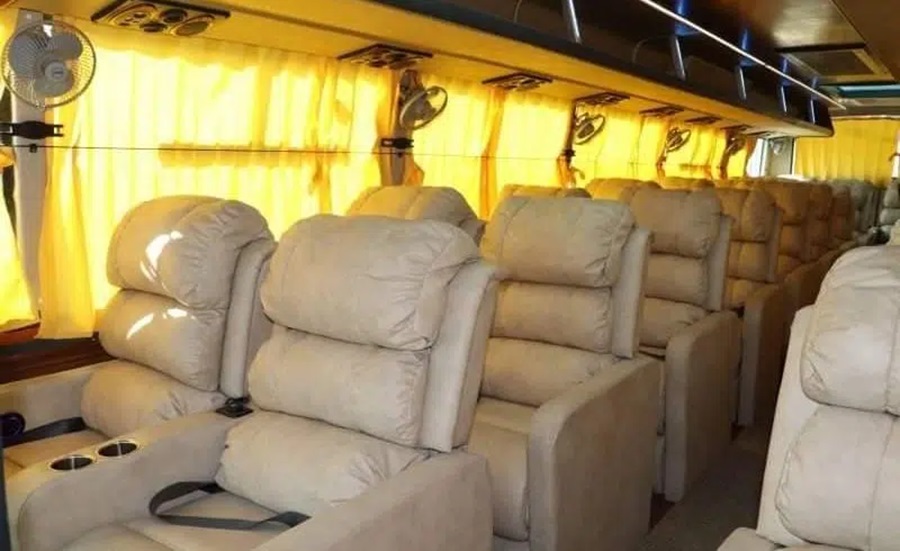
The Scenic Route to Pokhara
- Diverse Landscapes: As you travel from Kathmandu to Pokhara, the scenery shifts dramatically, offering views of verdant hills, meandering rivers, and charming rural villages.
- Cultural Insight: This drive provides a unique opportunity to observe Nepalese people’s everyday life outside the capital’s urban sprawl, showcasing the country’s rural heartland.
An Evening of Serenity at Lakeside, Pokhara
- Tranquil Ambiance: Upon reaching Pokhara, you’ll immediately notice the calm and scenic environment. Known as the gateway to the Annapurna Base Camp Trek, Pokhara is famed for its natural beauty and calming atmosphere.
- Explore Lakeside Pokhara: Spend your evening wandering through Lakeside, the city’s bustling tourist hub. This lively area, adjacent to the picturesque Phewa Lake, has many shops, cafes, and restaurants.
- Lake Activities and Relaxation: Enjoy a stroll by the lake, enjoy a serene boat ride, or relax in a cafe. The panoramic view of the Annapurna and Dhaulagiri ranges adds an awe-inspiring backdrop to your evening.
- Perfect Blend of Leisure and Excitement: With its vibrant yet laid-back charm, Lakeside Pokhara offers an ideal setting to relax and mentally prepare for the trekking journey.
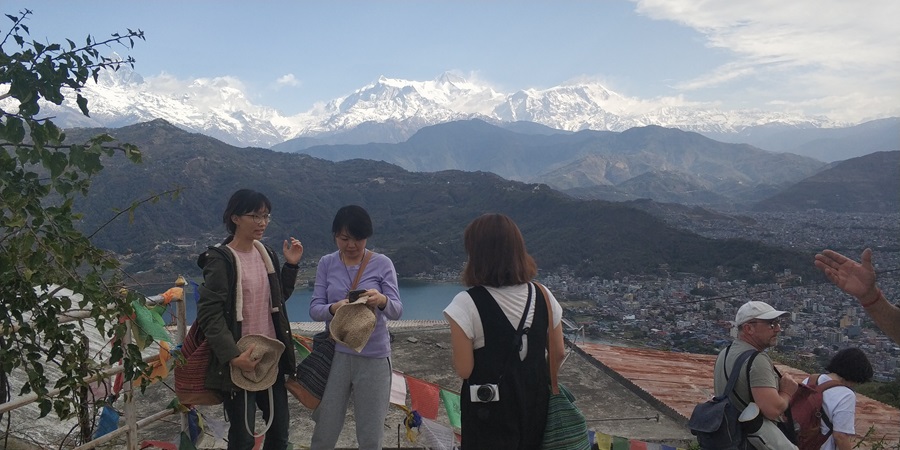
This day in Pokhara is integral to your Annapurna Base Camp Trek experience.
It offers a taste of Nepal’s stunning natural beauty and rich cultural fabric, setting the stage for an exciting trekking adventure.
Embark on the first leg of your Annapurna Base Camp Trek with a scenic and short drive from Pokhara to Nayapul, marking the transition from urban settings to the enchanting rural landscapes of Nepal.
This journey, lasting about 1 to 2 hours, offers a glimpse into Nepal’s countryside’s serene and rustic life.
The Drive to Nayapul: Gateway to the Annapurna Trek
- Scenic Transition: The drive to Nayapul is more than just a commute; it’s a picturesque journey that takes you away from the bustling cityscapes into the serene heart of rural Nepal.
- Starting Point of the Trek: Nayapul, serving as the commencement point of the trek, is where you’ll first feel the exhilarating pulse of adventure that awaits on the Annapurna Base Camp Trek.
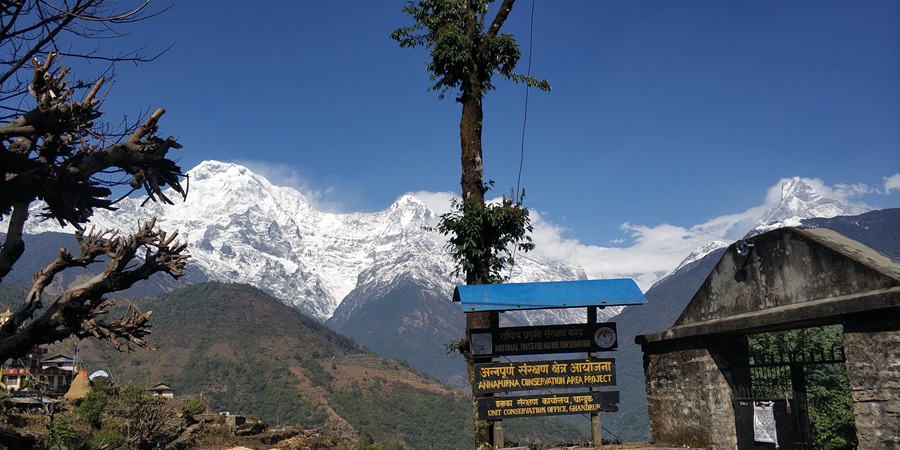
Trekking Towards Tikhedhunga
- An Easy Start: The trek from Nayapul to Tikhedhunga is relatively gentle, making it an excellent introduction to trekking in the Annapurna region. It’s a day filled with moderate walking, perfect for acclimatizing the trail.
- Cultural and Natural Tapestry: As you trek towards Tikhedhunga, the trail takes you through quaint villages, verdant farmlands, and gently undulating hills. It’s a delightful journey that marries cultural insights with natural beauty.
- Local Life and Scenic Views: Witness the rhythm of local life in the foothills of the Annapurna and soak in the picturesque vistas of valleys and rivers along the way.
- Arrival at Tikhedhunga: Concluding your day’s trek at Tikhedhunga, you’ll be greeted by the tranquil charm of this Himalayan village. It’s an ideal spot for an overnight stay, offering peace to relax and rejuvenate.
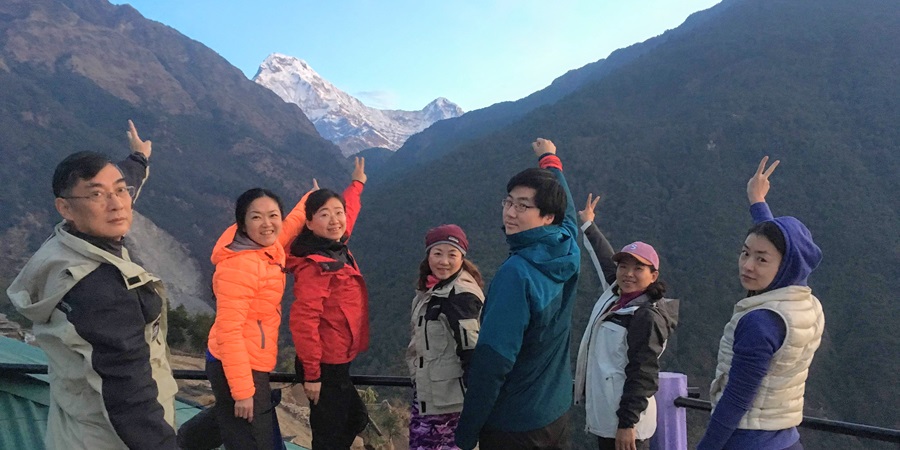
Your first day of trekking to Tikhedhunga sets the tone for an incredible journey through the Annapurna region.
It’s a blend of physical trekking, cultural immersion, and the sheer beauty of nature, laying the foundation for an unforgettable trekking experience.
The segment from Tikhedhunga to Ghorepani is a standout experience on the Annapurna Base Camp Trek, distinguished by its journey through enchanting rhododendron forests.
This stretch is not just a trek; it’s a passage through a natural wonderland that captures the essence of the Himalayan wilderness.
The Rhododendron-Laden Trails
- Enchanting Himalayan Forests: As you depart Tikhedhunga, you’ll find yourself in sprawling rhododendron forests. In spring, these woods are a spectacle of vibrant blooms, creating a stunning display of natural beauty.
- Flora and Fauna Galore: The trek is a haven for nature lovers. The biodiversity includes various plant species and birdlife, with occasional sightings of wildlife that add an element of surprise to your journey.
- Himalayan Vistas: The trail meanders through the forest, offering sporadic yet spectacular views of the snow-capped peaks of the Himalayas, emerging majestically above the lush foliage.
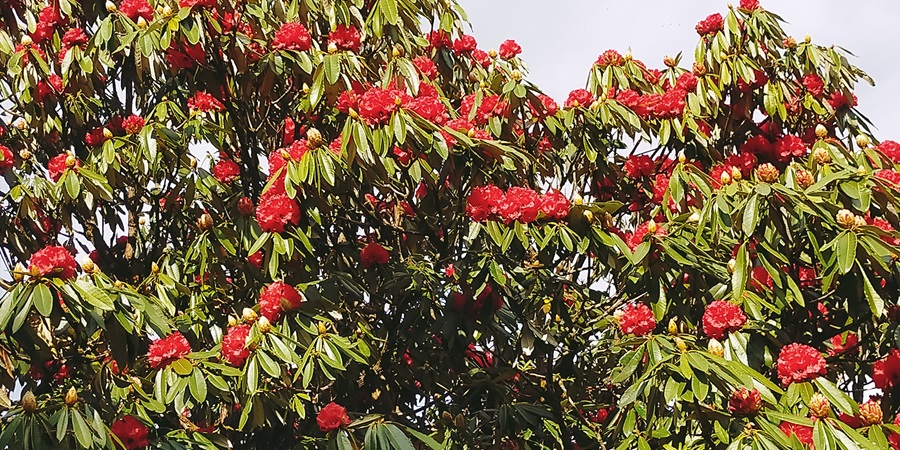
The Charm of Ghorepani
- A Scenic Mountain Hamlet: Your day ends at Ghorepani, a picturesque mountain village. Known for its breathtaking panoramic views, Ghorepani is a trekkers’ paradise.
- Cultural and Community Warmth: Ghorepani is rich in the cultural heritage of the Gurung and Magar communities. The village’s teahouses provide a cosy retreat, allowing you to immerse yourself in local traditions and hospitality.
- A Vantage Point for Natural Spectacles: The elevation of Ghorepani makes it an ideal location for witnessing stunning sunrises and sunsets over the Annapurna and Dhaulagiri ranges, a highlight for many trekkers.
A Day of Natural and Cultural Exploration
This day of the Annapurna Base Camp Trek blends Nepal’s natural splendour and cultural richness.
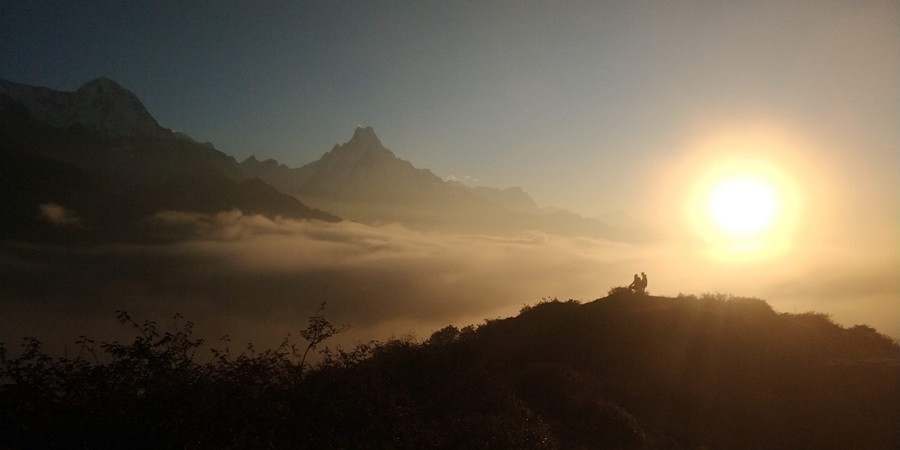
Trekking from Tikhedhunga to Ghorepani offers a fulfilling experience, connecting you with the heart of the Annapurna region.
It’s a day that combines nature’s serenity with Nepalese hospitality’s warmth, making it a memorable part of your Himalayan adventure.
The fifth day of your journey on the Annapurna Base Camp Trek begins with an early morning ascent, a moment filled with anticipation and excitement.
The destination is Poon Hill, one of the most iconic viewpoints in the Himalayas, renowned for its breathtaking sunrise views over the Annapurna and Dhaulagiri ranges.
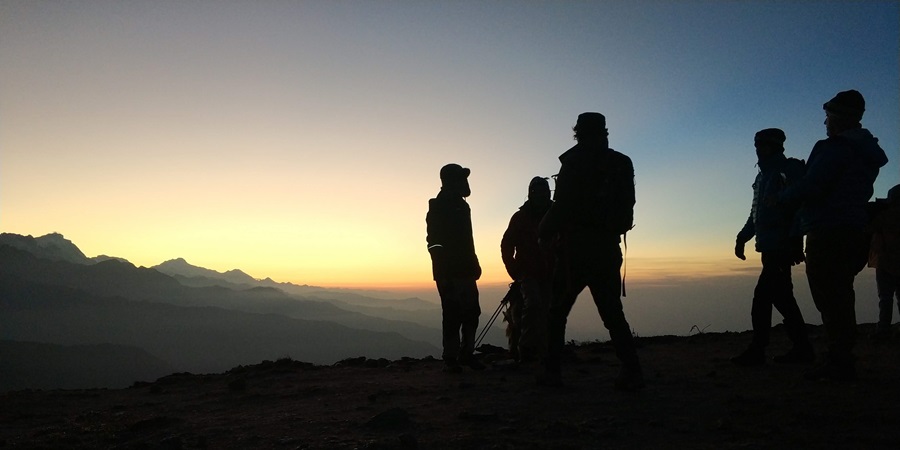
Awe-Inspiring Start at Poon Hill
- Spectacular Sunrise: Reaching Poon Hill in the early hours, you’re greeted by the mesmerizing sight of the first sun rays bathing the snow-capped peaks in golden hues. The panoramic vista from Poon Hill is a trekker’s dream, offering a 360-degree view of the majestic Himalayas.
- Rewarding Ascent: The trek to Poon Hill, though steep, is relatively short. The journey upwards is a thrilling blend of anticipation and physical exertion, culminating in a truly rewarding experience.
Journey Through the Forests to Tadapani
- Return to Ghorepani: After witnessing the stunning sunrise, you’ll return for breakfast, refuelling for the next leg of your trek.
- Enchanting Forest Trails: The path to Tadapani takes you through dense forests rich in biodiversity. The tranquillity of the forest, coupled with the chirping of birds and occasional clearings, offers serene and captivating moments.
- Diverse Terrain: The trek to Tadapani is a harmonious mix of uphill and downhill trails enveloped in the lush greenery of the Himalayan forests.
- Arrival at Tadapani: This picturesque village, surrounded by forests, offers stunning views of Annapurna South, Hiunchuli, and the iconic Machapuchare (Fishtail) mountains. Tadapani’s teahouses provide a cosy stop to end your day.
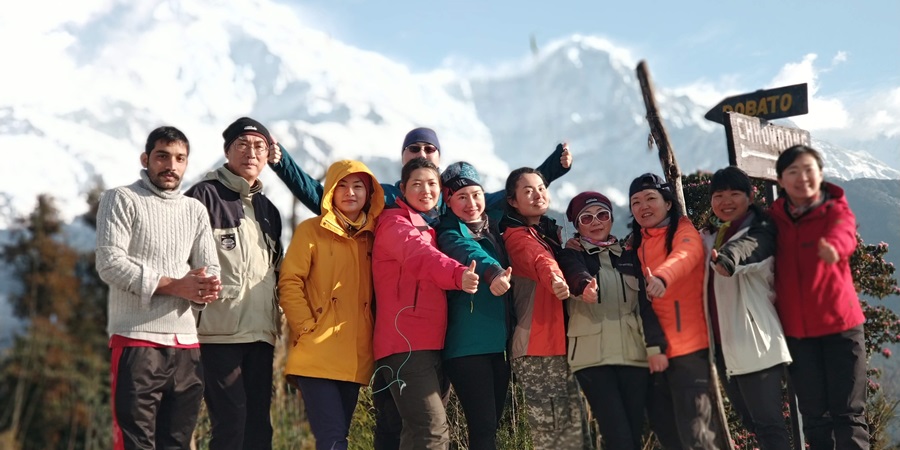
A Day of Splendor and Serenity
Your fifth day on the Annapurna Base Camp Trek perfectly blends nature’s grandeur and the peacefulness of the Himalayan forests.
From the unforgettable sunrise at Poon Hill to the scenic trek to Tadapani, this day encapsulates the essence of trekking in the Annapurna region – a journey of spectacular sights and serene experiences.
On the sixth day of your Annapurna Base Camp Trek, you’ll embark on a journey that weaves through charming villages and past verdant crop fields, offering a glimpse into the Annapurna region’s rural life and agricultural landscape.
A Cultural Trek Through Nepalese Villages
- Vibrant Rural Experience: As you leave Tadapani, the trail takes you through a series of small villages where you can witness the daily life and culture of the local communities in the heart of the Himalayas.
- Passing Through Agricultural Lands: The path is lined with lush crop fields, showcasing the rich agricultural practices of the region. This trek offers an opportunity to see a variety of crops and farming techniques unique to the area.
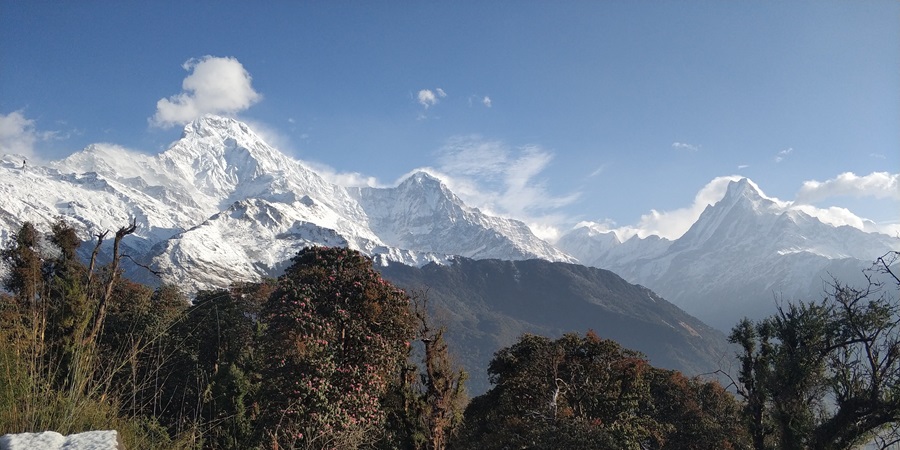
The Scenic Route to Chhomrong
- Diverse Landscapes: The trail’s diversity provides a dynamic trekking experience as you transition from rural settlements to the natural beauty of terraced agriculture.
- Interaction with Locals: Trekking through these villages allows for meaningful interactions with the local people, adding a layer of cultural richness to your journey.
Arrival at Chhomrong
- A Gateway to Annapurna Base Camp: Chhomrong, your destination for the day, is a beautiful and lively village that serves as a critical stop on the trek to Annapurna Base Camp. It offers stunning views of the surrounding mountains, including the Annapurna range and the iconic Machapuchare (Fishtail) peak.
- A blend of Tradition and Comfort: The village is known for its mix of traditional lifestyle and modern trekking amenities, providing a comfortable and welcoming atmosphere for trekkers.
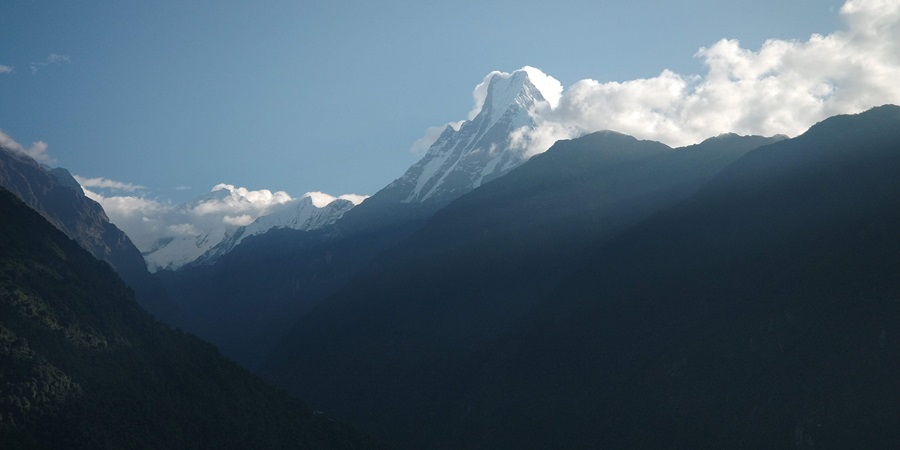
Embracing the Local Ambiance
- Evening Relaxation and Exploration: Spend your evening in Chhomrong, absorbing the serene mountain atmosphere, exploring the village, and enjoying the local community’s hospitality.
- Preparation for the Trek Ahead: This stop is an excellent opportunity to rest and rejuvenate as you prepare for the more challenging segments of your Annapurna Base Camp Trek.
The sixth day of the trek is not just a physical journey; it’s an immersive experience into the heart of Nepalese rural life and agriculture.
As you make your way to Chhomrong, the day combines the charm of village life with the natural beauty of Nepal’s farming landscapes.
The seventh day of your Annapurna Base Camp Trek unfolds with a scenic trek alongside the Modi Khola River, guiding you to the peaceful enclave of Dovan.
This part of the trek is a symphony of natural beauty, showcasing the tranquil and majestic essence of the Annapurna region.
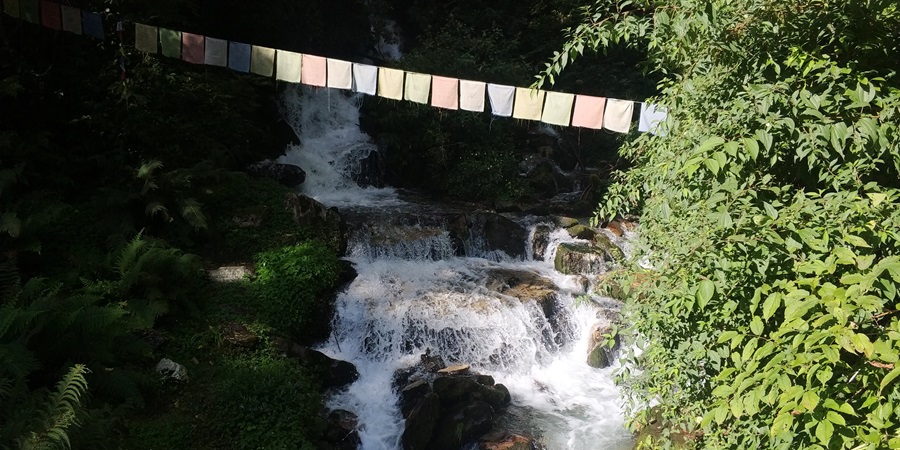
A Riverside Journey to Dovan
- Descending Toward Modi Khola: As you depart from Chhomrong, the trail gently slopes down towards the Modi Khola River. This descent introduces you to a serene landscape where the soothing sounds of the river accompany your trek.
- Lush Greenery and Forest Trails: En route to Dovan, you’ll be enveloped by the lush greenery of the dense forests, offering a refreshing and picturesque backdrop. The trail is a tranquil experience, fully immersing yourself in the Himalayas’ natural splendour.
The Charm of Dovan
- A Peaceful Stopover: Dovan, a modest yet charming stop on the trekking route, extends a warm welcome to trekkers. It’s a small settlement that promises a peaceful retreat amidst the grandeur of towering peaks and thick forests.
- Cosy Teahouse Accommodations: The teahouses in Dovan, though essential, provide a comfortable and cosy resting place. Their simplicity adds to the rustic charm of the trekking experience.
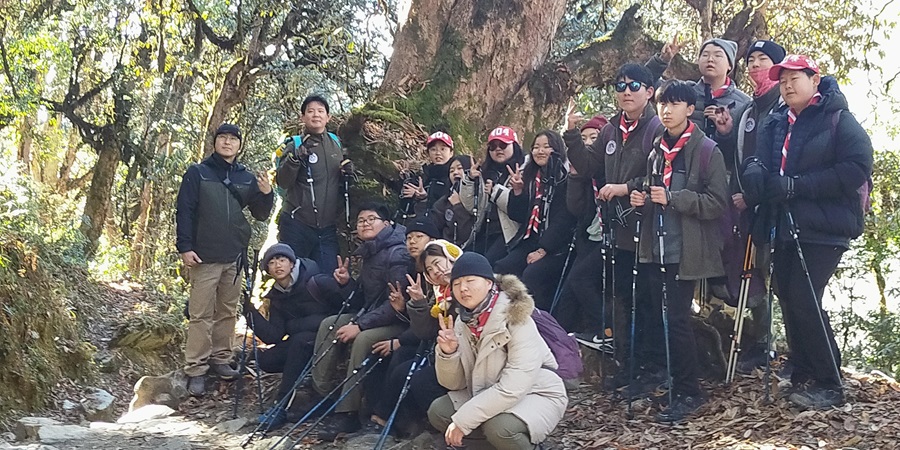
Embracing the Heart of the Himalayas
- A Day of Reflection and Connection: Trekking from Chhomrong to Dovan along the Modi Khola is not just a physical journey; it’s an opportunity to connect with nature and reflect on the incredible trekking experience thus far.
- The Quintessential Annapurna Trekking Experience: This day captures the essence of the Annapurna Base Camp Trek—a harmonious blend of tranquillity, natural beauty, and the spirit of adventure in the Himalayas.
The journey to Dovan is a highlight of the trek, offering an opportunity to appreciate the quieter yet equally mesmerizing aspects of the Annapurna region.
As you rest in Dovan, you’re halfway through an extraordinary adventure that resonates with the beauty and serenity of the Himalayan landscape.
The pinnacle of your Annapurna Base Camp Trek is finally within reach – the awe-inspiring arrival at Annapurna Base Camp (ABC).
This moment signifies more than just a destination; it’s the culmination of an extraordinary journey through the majestic Himalayas, a testament to your perseverance, wonder, and the enduring allure of nature.
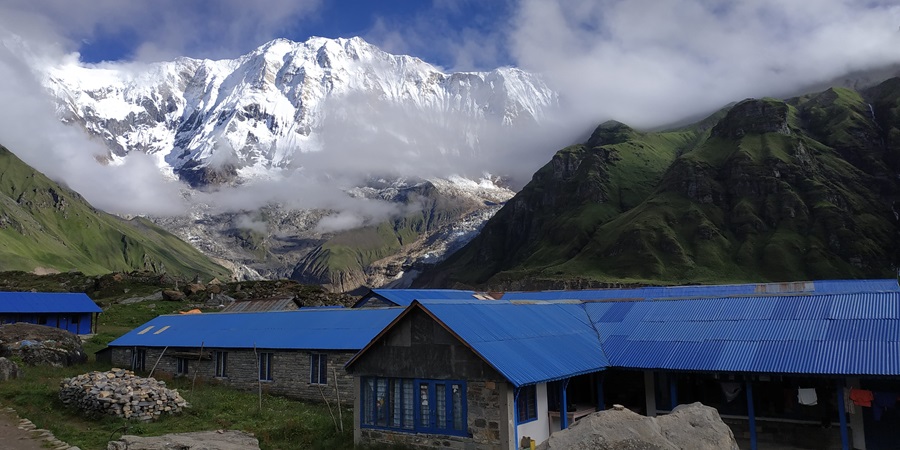
The Final Ascent to Annapurna Base Camp
- Surrounded by the Himalayan Giants: As you approach ABC, you are greeted with some of Earth’s most spectacular mountain scenery. The base camp is set within a natural amphitheatre of towering peaks, offering a 360-degree panoramic view that is nothing short of breathtaking.
- Heart of the Annapurna Range: At the Annapurna Base Camp, you stand amidst colossal peaks, including Annapurna I, Annapurna South, the iconic Machapuchare (Fishtail), and Hiunchuli. Standing at ABC, surrounded by these giants, is surreal and profoundly moving.
A Moment of Celebration and Reflection
- Celebrating Your Achievement: Reaching Annapurna Base Camp is a time for jubilation and contemplation. It’s an opportunity to reflect on the journey, the magnificent vistas you’ve encountered, and the personal milestones you’ve achieved.
- Breathtaking Views and Triumph: The unforgettable views from ABC and the overwhelming sense of accomplishment are the ultimate rewards for your trekking endeavour, making every step of the journey profoundly meaningful.
Annapurna Base Camp: More Than a Trek
- Immersed in Magnificence: Spending time at the base camp, in the embrace of the Annapurna massif, is an experience that transcends the physical trek. It’s an exploration of both the outer world’s grandeur and your inner resilience.
- A Journey of Self-Discovery: At ABC, you realize that the Annapurna Base Camp Trek is not merely a physical challenge but a voyage into self-discovery, celebrating the human spirit’s capacity to overcome and appreciate the sublime beauty of our planet.
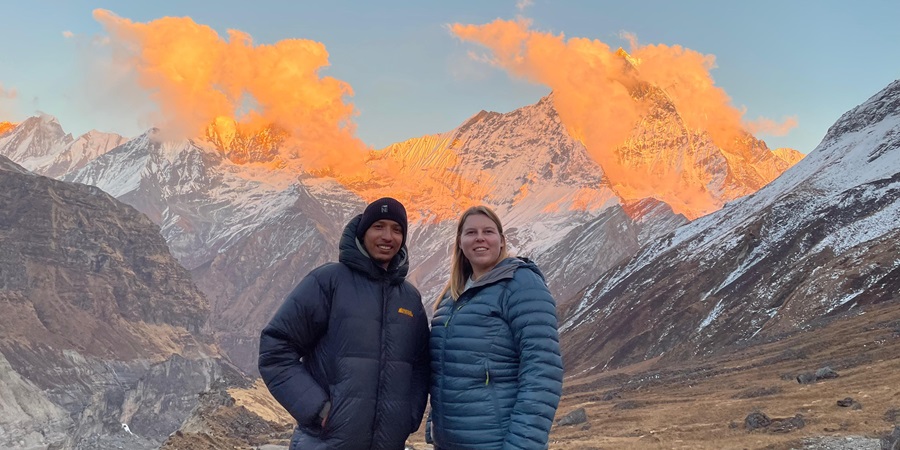
This defining moment at Annapurna Base Camp is a highlight of your trek. At this point, the enormity of nature’s beauty and your journey converge, creating memories that will last a lifetime.
As you descend from the heights of Annapurna Base Camp towards Bamboo, you embark on a different yet equally rewarding phase of your Annapurna Base Camp Trek.
This part of the trek is a physical descent and a period for reflecting and appreciating the incredible feat you’ve accomplished.
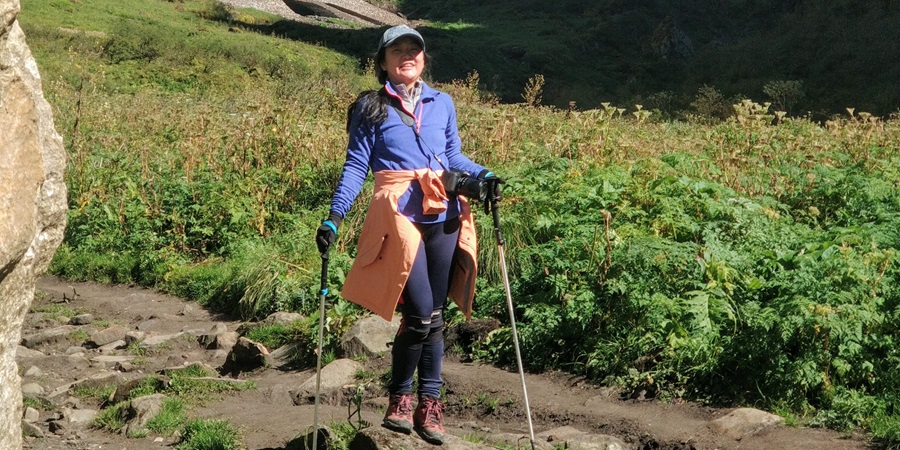
A New Perspective on Familiar Trails
- Retracing Steps with Renewed Insight: The journey back to Bamboo involves retracing the paths previously taken, but now with a fresh perspective and a sense of triumph. The landscapes you pass during the ascent will reveal new details and aspects, enhancing your connection to the trail.
- Majestic Backdrop on Descent: As you trek downwards, the Annapurna range continues to dominate the skyline, offering a spectacular backdrop and reminding you of the grandeur of your adventure.
The Tranquil Trek to Bamboo
- Easier on the Body: The descent to Bamboo is generally gentler on your knees and body. It’s a more relaxed trek, allowing you to savour the beauty of the surroundings with less physical exertion.
- Enchanting Forests Revisited: The trail takes you through the same magical forests but with the flora and fauna presenting themselves anew. This part of the trek is an opportunity to observe and appreciate the natural environment from a different vantage point.
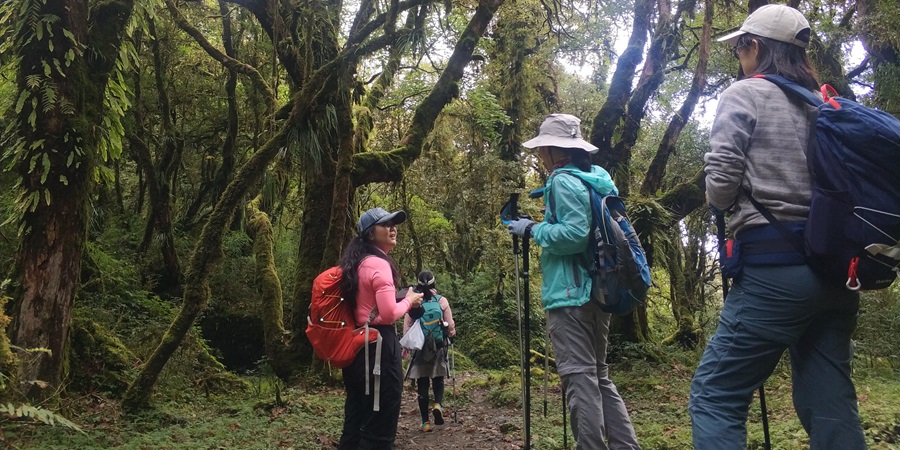
The Charm of Bamboo
- A Welcoming Stopover: Bamboo is a quaint and serene stop on the trekking route, known for its lovely teahouses and the friendly hospitality of the local people.
- Rest and Rejuvenation: The teahouses in Bamboo provide a comfortable and peaceful environment, perfect for resting your legs and rejuvenating your spirit. It’s a chance to relax, share stories with fellow trekkers, and soak in the tranquil atmosphere of the Himalayas.
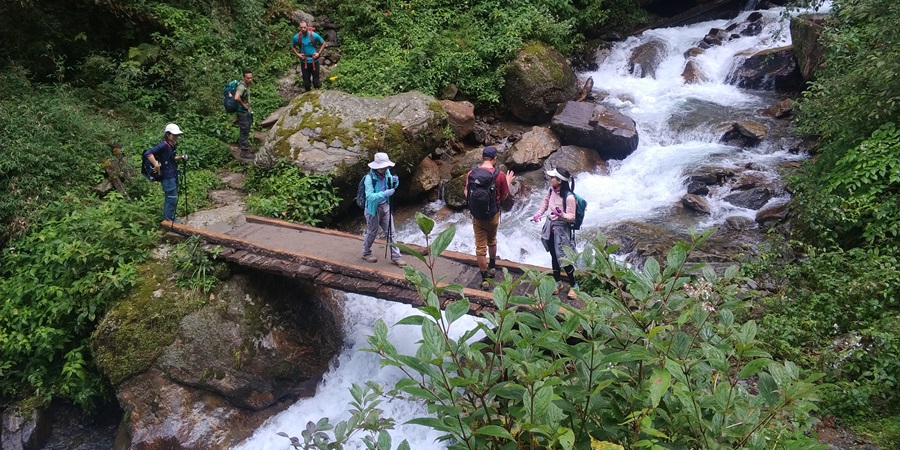
Internalizing the Trekking Experience
The trek from Annapurna Base Camp to Bamboo is an integral part of your journey, allowing you to internalize and reflect on the experiences and achievements of your trek.
It’s a time to create lasting memories and to truly appreciate the majestic beauty and spirit of the Annapurna region.
Embark on a rejuvenating segment of your Annapurna Base Camp Trek as you descend to the picturesque village of Jhinu.
Known for its therapeutic natural hot springs, Jhinu is a highlight for many trekkers, offering a blend of cultural immersion and natural relaxation.
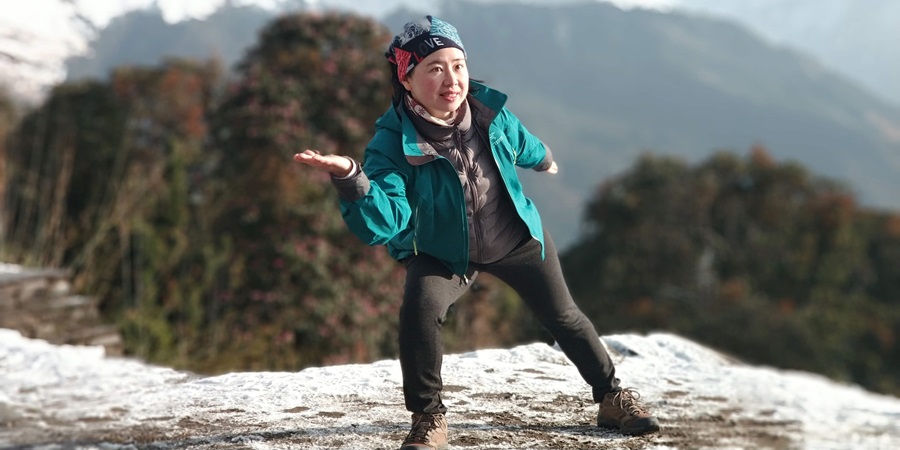
Journey to Jhinu: A Trek through Nature’s Beauty
- Scenic Trekking Path: The trek to Jhinu is integral to the Annapurna Base Camp Trek, showcasing the region’s diverse landscapes. You’ll navigate through lush forests and past terraced fields, enjoying the serene beauty of rural Nepal.
- Cultural Insights: The village of Jhinu provides a window into the local lifestyle, where the traditions of the Himalayas are still vibrantly alive. It’s an excellent opportunity to engage with the culture and customs of the Annapurna region.
The Therapeutic Jhinu Hot Springs
- Natural Wellness Retreat: The natural hot springs in Jhinu are a much-anticipated stop for trekkers on the Annapurna Base Camp Trek. Located by the Modi Khola River, these thermal springs offer a serene setting to unwind and rejuvenate after the rigorous trek.
- Community and Relaxation: The hot springs serve as a communal gathering spot, creating an atmosphere of camaraderie among trekkers and locals. It’s a place to share stories, relax in the warm waters, and enjoy the tranquillity of the Himalayas.
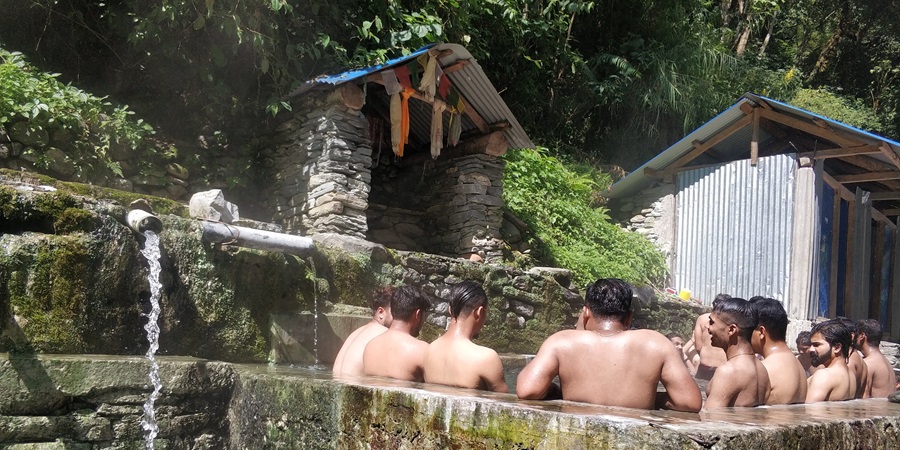
Embracing Serenity in the Himalayas
- Therapeutic Experience: Soaking in Jhinu’s hot springs is about physical relaxation and mental rejuvenation. It’s a time to reflect on the journey, appreciate the natural wonders of the Annapurna Base Camp Trek, and revitalize the remaining trek.
- A Memorable Trekking Highlight: The visit to Jhinu, with its enchanting hot springs, is a distinctive feature of the Annapurna Base Camp Trek. This experience blends the essence of Himalayan natural beauty with a touch of wellness, adding to the richness of your trekking adventure.
The trek to Jhinu and the indulgence in its hot springs epitomize the unique experiences the Annapurna Base Camp Trek offers.
It’s a perfect example of how the trek goes beyond just hiking, providing opportunities for cultural engagement and natural rejuvenation amidst the majestic settings of the Himalayas.
As your journey on the Annapurna Base Camp Trek approaches its conclusion, the final trek back to Nayapul and the subsequent drive to Pokhara signifies the completion of an extraordinary adventure through the heart of the Himalayas.
The Last Trekking Day to Nayapul
- Reflective Journey Back: The trek from Jhinu to Nayapul is an opportunity to retrace your steps while reflecting on your incredible experiences. This final trekking day allows you to absorb the stunning Himalayan landscape once again, now enriched with the perspective of your completed journey.
- A Tapestry of Memories: As you walk, the memories of the challenges you’ve overcome, the natural beauty you’ve witnessed, and the bonds you’ve formed with fellow trekkers come together, creating a lasting mosaic of unforgettable experiences.
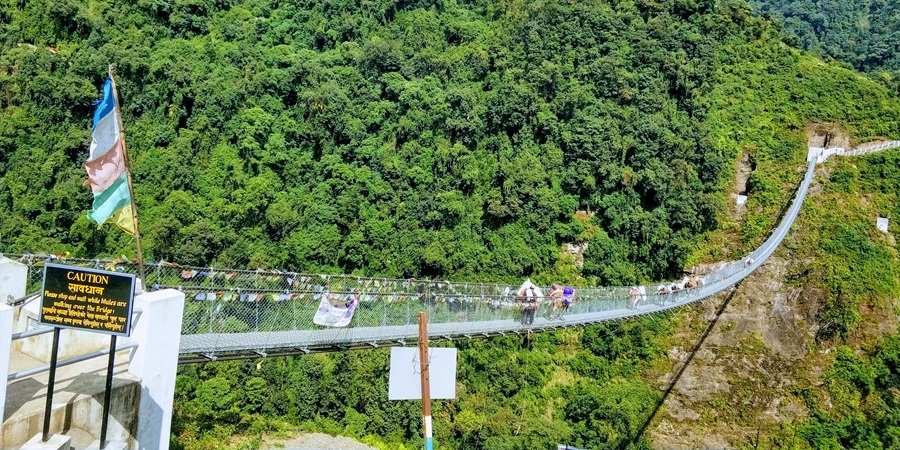
The Scenic Drive to Pokhara
- Transition to Urban Comforts: The drive from Nayapul to Pokhara marks a shift from serene mountain trails to vibrant city life. This journey allows you to rest and enjoy the diverse landscapes as you transition from the rural to the urban.
- Returning to Pokhara: Reaching Pokhara signifies the official end of your trek. Known for its beautiful lakes, lively ambience, and comfortable amenities, Pokhara is the ideal place to relax and celebrate the completion of your trek.
Celebrating Your Trek in Pokhara
- Relaxation and Exploration: In Pokhara, you can indulge in various activities and sightseeing, gently easing back into the conveniences of city life while still being surrounded by the beauty of Nepal.
- A Journey of Personal Growth: Completing the Annapurna Base Camp Trek in Pokhara is more than just finishing a physical trek; it starts a lifelong journey enriched with memories and a newfound appreciation for nature, culture, and personal resilience.
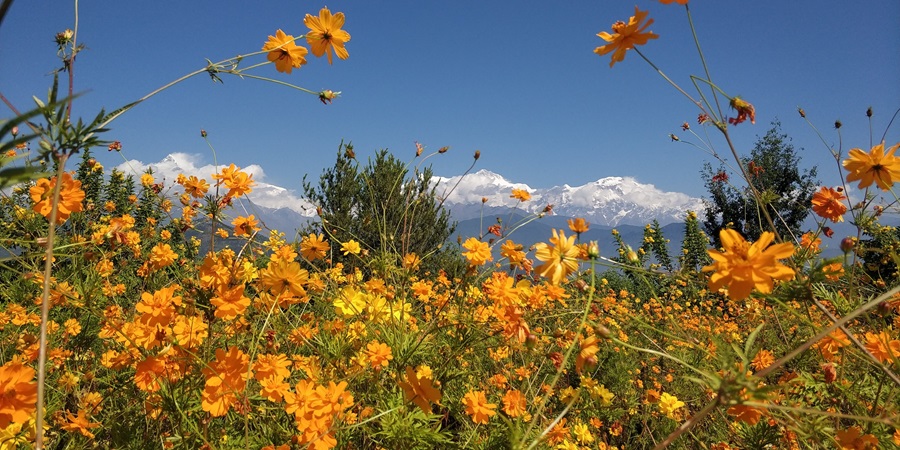
Your return to Pokhara is a time to acknowledge your achievements and the transformative experiences of the Annapurna Base Camp Trek.
It’s a celebration of the journey you’ve embarked on, filled with moments of wonder, camaraderie, and self-discovery.
As your adventure on the Annapurna Base Camp Trek concludes, the journey back to Kathmandu by road marks the final chapter of your remarkable Himalayan experience.
This return trip is a period for relaxation and reflection, transitioning from the tranquillity of the mountains to the lively urban energy of Nepal’s capital.
Scenic Drive from Pokhara to Kathmandu
- Picturesque Landscapes: The drive back to Kathmandu is a scenic excursion, winding through the hills and valleys of Nepal. It offers a fresh perspective of the Nepalese countryside, seen from the comfort of your vehicle.
- A Diverse Panorama: This journey lets you witness Nepal’s varied landscapes for the last time on your trek, from verdant lowlands to lively towns and villages dotting the route.
- Reflective and Restful Travel: The drive is several hours long, providing ample time to rest and reminisce about the extraordinary time spent in the Annapurna region. As the urban scenery of Kathmandu comes into view, you re-enter the bustling city life.
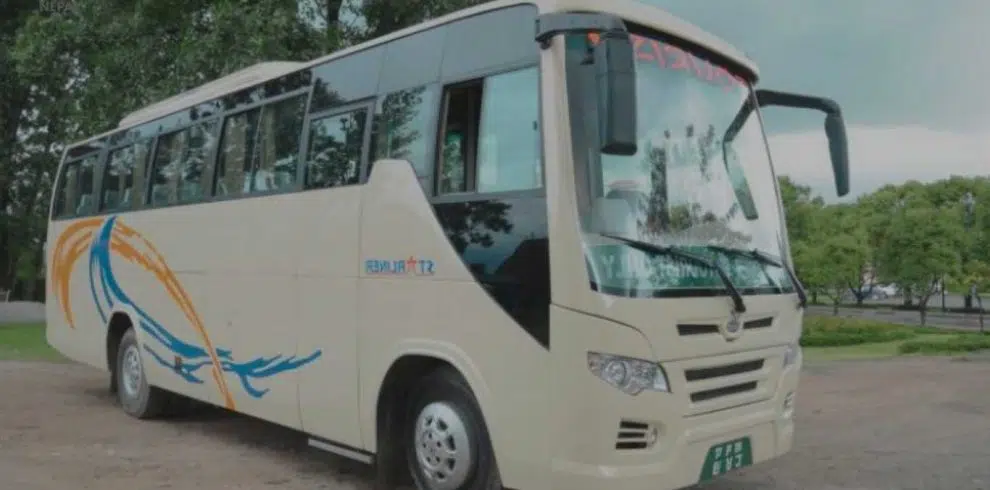
A Celebration of Achievement: Farewell Dinner in Kathmandu
- A Festive Conclusion: Upon your arrival in Kathmandu, a special farewell dinner celebrates the completion of your Annapurna Base Camp Trek. This dinner is an opportunity to celebrate your accomplishments, the friendships forged, and the unforgettable experiences shared.
- Savouring Traditional Nepalese Flavors: The farewell dinner often showcases traditional Nepalese cuisine, offering a final taste of the country’s rich culinary heritage. It’s a fitting end to your trekking journey, enjoyed in the company of your fellow trekkers and guides.
- Sharing Stories and Memories: The dinner is a time for storytelling, laughter, and maybe even discussions of future adventures. It’s an occasion to reflect on the journey and appreciate the bonds created.

Returning to Kathmandu and partaking in the farewell dinner brings a sense of completion to your Annapurna Base Camp Trek.
It’s a moment to acknowledge your challenges, the natural wonders you’ve beheld, and the personal growth achieved on this life-changing trek.
As you conclude your incredible journey on the Annapurna Base Camp Trek, the final day brings you back to the bustling city life of Kathmandu, offering a moment to transition and reflect on your extraordinary experiences in the Himalayas.
The Scenic Drive Back to Kathmandu
- Relaxing Road Trip: Departing from Pokhara, your drive back to Kathmandu is a scenic route through the diverse landscapes of Nepal. This journey gives you a final glimpse of the country’s natural beauty, from lush valleys to vibrant towns and villages.
- Reflective Moments: The drive is an excellent opportunity to rest and contemplate the memorable days spent trekking in the Annapurna region. Witnessing the transition from rural backdrops to Kathmandu’s urban setting signifies the conclusion of your trekking adventure.
Celebratory Farewell in Kathmandu
- Special Dinner to Commemorate the Trek: Upon arrival in Kathmandu, a celebratory farewell dinner awaits. This gathering is not just a meal; it’s a festive celebration of your achievements, the camaraderie developed with fellow trekkers, and the unforgettable moments of your trek.
- Savoring Local Flavors: The dinner often features traditional Nepalese cuisine, allowing you to enjoy the local flavors one last time, encapsulating the essence of your Nepalese journey.
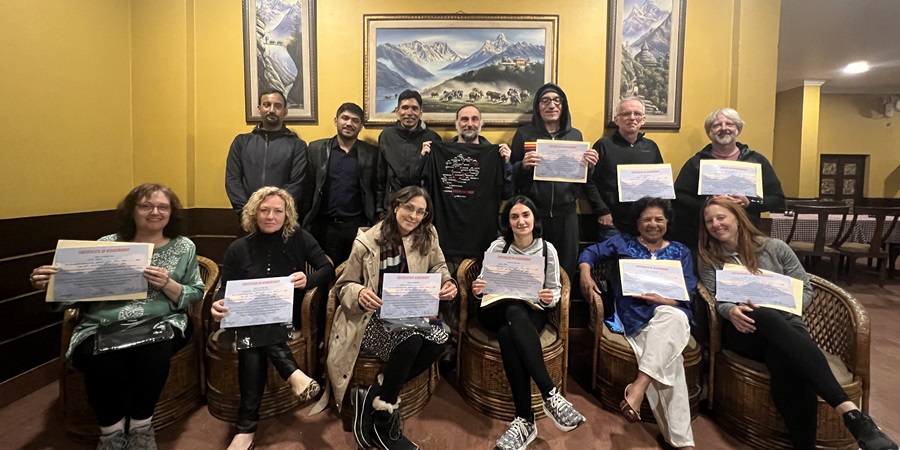
Departure and Lasting Impressions
- Closing Chapter of Your Trek: As you prepare to depart Kathmandu, take a moment to reflect on the entire Annapurna Base Camp Trek – the challenges faced, the scenic beauty encountered, and the personal growth experienced.
- Fond Farewells and Future Adventures: We bid you a heartfelt farewell, wishing you a safe journey home, carrying the rich tapestry of experiences and memories from the Annapurna Base Camp Trek and perhaps the inspiration for future adventures.
Completing your trek in Kathmandu is not just the end of a physical journey but the beginning of a lifelong journey enriched with the splendour of the Himalayas and personal insights gained along the way.
Added Insights
Includes/Excludes
What's Included?
- Scenic Tourist Bus Journey: Experience a comfortable and picturesque bus ride to and from Pokhara, the gateway to the Annapurna Base Camp Trek.
- Relaxing 3-Star Hotel Stay: Enjoy a comfortable stay in a 3-star hotel in Pokhara, complete with breakfast – the perfect way to relax before and after your trek.
- Private Transportation: We provide convenient private transfers to and from Nayapul, marking the start and end points of your Annapurna Base Camp Trek.
- Hassle-Free Permit Arrangement: All essential trekking permits and documentation for your journey are efficiently arranged by us.
- Professional and Experienced Guide: An English-speaking trekking guide will lead you on the Annapurna Base Camp Trek. All guide expenses, including insurance, are covered.
- Supportive Porter Assistance: Our package includes reliable porter services (1 porter for every two trekkers), capable of carrying 15-20 kg, with comprehensive insurance for each porter.
- Nutritious and Delicious Meals: Enjoy various healthy and tasty meals (breakfast, lunch, and dinner) during your trek.
- Cultural Immersion: Stay in authentic teahouses along the trek, offering a unique cultural experience and local hospitality.
- Essential Gear Supplied: We provide necessary trekking gear like sleeping bags and down jackets for the duration of your trek (to be returned post-trek).
- Walking Poles and Communication Tools: Walking poles are provided for assistance, along with Nepali SIM cards for communication during your trek.
- Comprehensive First Aid Kit: A well-equipped first aid kit is available for any emergencies that may arise during your trek.
What's Excluded?
- Nepalese Visa Fee: All trekkers must factor in the visa fee for Nepal, a necessary expense for entering the country for your Annapurna Base Camp Trek.
- Travel Insurance: Obtaining comprehensive travel insurance, especially one that covers high-altitude trekking, is crucial for your safety and peace of mind during the trek.
- Extra Accommodation in Kathmandu: Any additional hotel stays in Kathmandu, not included in the trek package, will incur extra charges.
- Meals in Pokhara: While on your Annapurna Base Camp Trek, lunch and dinner in Pokhara are not included in the package and will be additional expenses.
- Additional Accommodation Needs: Extra nights in Kathmandu or Pokhara due to early arrival or late departure, related to your trek, are excluded from the package.
- International Airfare: Flights to and from Kathmandu for the Annapurna Base Camp Trek are not included in the package.
- Excess Baggage Fees: Be prepared to manage any excess baggage charges incurred during your flights.
- Personal Expenses: Costs like laundry, phone calls, and other personal expenses during the trek are the responsibility of each trekker.
- Tips for Trekking Staff: Gratuities for guides, porters, and drivers, though not compulsory, are not included in the package and are greatly appreciated.
- Other Exclusions: Any services or items not explicitly mentioned in the included list for the Annapurna Base Camp Trek will be considered extra and are to be covered by the trekker.
Annapurna Base Camp Trek Important Information
Best Seasons for Annapurna Base Camp Trek
The Annapurna Base Camp Trek, a jewel in the crown of trekking in Nepal, is a journey profoundly influenced by your chosen season. Each season in the Annapurna region brings a unique set of weather patterns, scenic beauty, and challenges, making it crucial to select the time that aligns best with your trekking preferences.
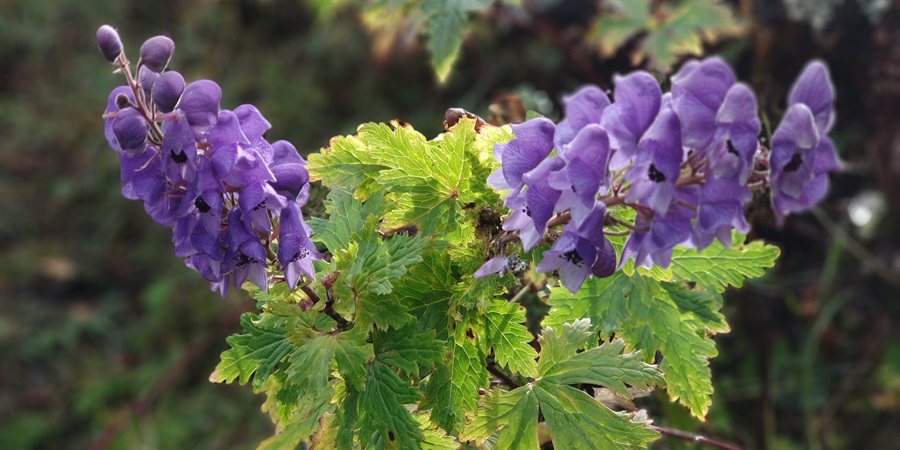
Spring (March to May): The Season of Rebirth
Spring in the Annapurna region, spanning from March to May, is a period that transforms the landscape into a trekker’s paradise, offering a perfect balance of climate, scenery, and trekking conditions. This season is highly recommended for those planning an Annapurna Base Camp Trek or any trek in Nepal.
Weather Patterns in Spring
- Temperature Range: The daytime temperatures during Spring usually hover between a pleasant 10°C to 20°C. These moderate temperatures are ideal for trekking as they provide a comfortable balance, not too hot, nor too cold.
- Evening Climates: While nights can be more relaxed, they are generally bearable, adding to the comfort of your trekking experience. It’s advisable to carry some warm layers for the evenings.
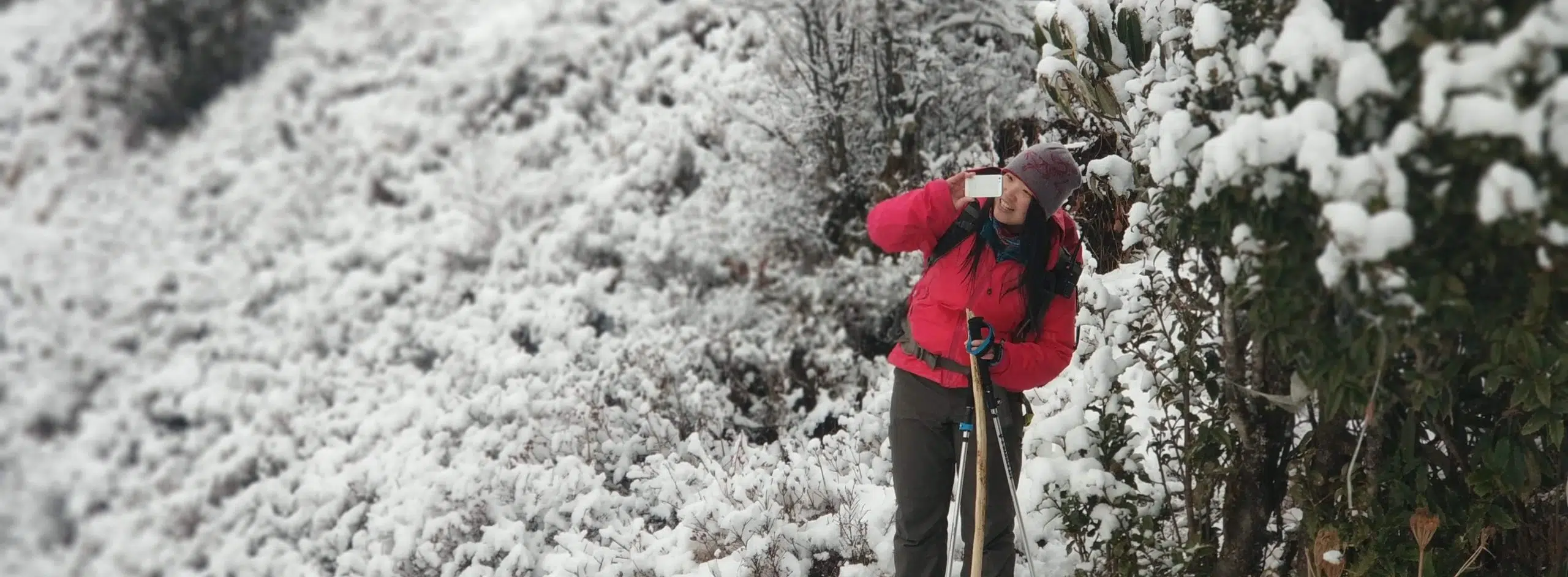
Advantages of Spring Trekking
- Lush Green Landscapes: Spring is when the Annapurna region is most vibrant. The trails are surrounded by lush greenery, providing a refreshing backdrop for trekkers.
- Clear Skies: This season is known for its stable weather and clear skies, offering uninterrupted views of the majestic Himalayan range, a key highlight for any trek in Nepal.
- Vibrant Rhododendron Blooms: The forests along the trails come alive with the bright colours of rhododendron blooms, adding a unique charm to the trekking experience.
Why Choose Spring for Your Trek?
- Ideal for Photography: Spring is a dream come true for photography enthusiasts. The clear skies and vibrant landscapes offer ample opportunities for capturing breathtaking shots.
- Experiencing the Mountains in Full Bloom: If you wish to witness the Himalayas surrounded by the beauty of nature in full bloom, Spring is the ideal time for your Annapurna Base Camp Trek.
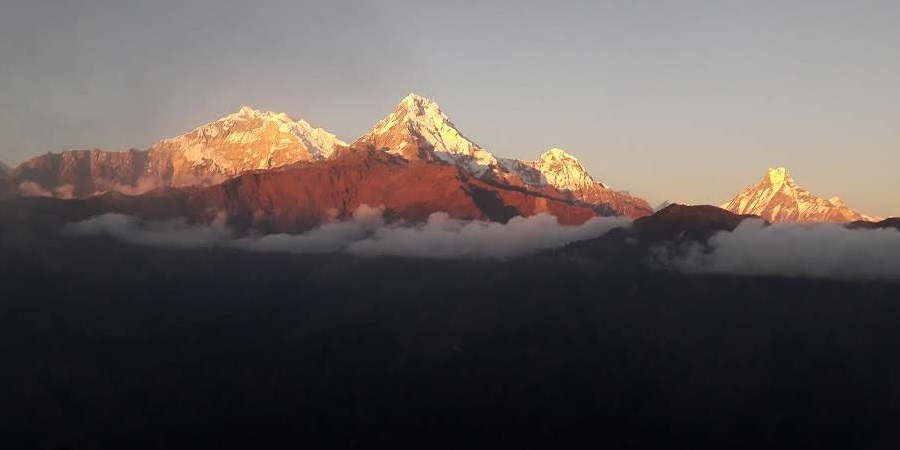
Autumn (September to November): The Golden Season
Autumn, spanning from September to November, is often hailed as the prime season for undertaking the Annapurna Base Camp Trek. This period is cherished by trekkers worldwide for its optimal weather conditions and stunning visual tapestry, making it an ideal time for anyone planning a trek in Nepal.
Weather Patterns in Autumn
- Temperature Range: During Autumn, the Annapurna region enjoys a mild climate with daytime temperatures typically ranging between 10°C to 15°C. These temperatures are perfect for trekking, offering a comfortable journey without the extremes of heat or cold.
- Stable Climatic Conditions: Post-monsoon, the weather stabilizes significantly, reducing the likelihood of unexpected rains and providing a reliably pleasant trekking environment.
Advantages of Autumn Trekking
- Crisp and Clear Air: The monsoon rains leave behind crystal clear air, significantly enhancing visibility. This clarity allows for some of the most spectacular views of the Annapurna mountain range.
- Golden and Green Landscapes: Autumn is characterized by its golden hues, mixed with the residual green of monsoon, creating a breathtaking backdrop for trekkers and photographers alike.

Why Choose Autumn for Your Trek?
- Peak Season for Trekking: Autumn is the most popular season for the Annapurna Base Camp Trek. The trails come alive with a vibrant mix of international and local trekkers, creating a lively and multicultural atmosphere.
- Guaranteed Good Weather: With the reduced risk of rainfall and stable temperatures, Autumn is synonymous with guaranteed good trekking conditions. It’s when you can be sure of clear skies and comfortable trekking.
- Cultural Experience: This season also coincides with several Nepalese festivals, offering trekkers a unique cultural insight in addition to the natural beauty.
Winter Trekking in the Annapurna Region: A Serene and Solitary Experience
Winter, encompassing the months from December to February, presents a unique and tranquil facet of the Annapurna Base Camp Trek. While colder temperatures mark this season, it also offers unparalleled peace and solitude, making it a compelling choice for trekkers who prefer a more solitary journey.

Weather Patterns in Winter
- Temperature Overview: During the winter, daytime temperatures in the Annapurna region typically stay around 5°C, providing a brisk but manageable trekking climate. However, as elevation increases, temperatures can drop significantly.
- Nighttime Chill: Nights are considerably colder, often dipping below zero. Adequate preparation with warm gear ensures comfort and safety during these colder periods.
Advantages of Winter Trekking
- Less Crowded Trails: One of the most significant advantages of a winter trek is the reduced number of trekkers on the trails. This offers a more personal and reflective experience of the Himalayas.
- Snow-Clad Landscapes: The higher regions of the trek will likely be blanketed in snow, transforming the landscape into a serene winter wonderland. The snowy vistas contrast starkly with the bustling, green trails of the warmer months.
Why Choose Winter for Your Trek?
- Solitude and Reflection: If you’re a trekker who cherishes solitude and the space for personal reflection, winter provides an ideal setting. The quiet trails and the stillness of the snow-covered mountains create a reflective and peaceful trekking experience.
- Preparation for the Cold: Winter trekking demands thorough preparation, especially regarding warm clothing and gear. If you are well-equipped and comfortable with chilly conditions, winter can offer an enriching trekking experience.
- Unique Perspective of the Annapurna Range: Trekking in winter allows you to see and experience the Annapurna range in a different light. The snow-covered peaks and the crisp winter air bring a fresh perspective to these majestic mountains.
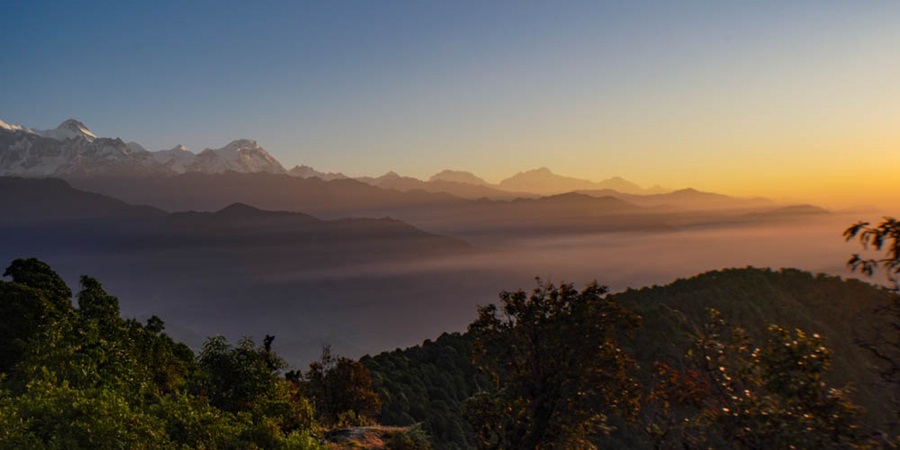
Monsoon to the Annapurna Base Camp Trek: Embracing the Lush and the Wet
The Monsoon season in the Annapurna region, spanning from June to August, offers a dramatically different experience for those undertaking the Annapurna Base Camp Trek. It’s a time when the trails are less crowded, and the landscapes are at their most vibrant, appealing particularly to trekkers who don’t mind a bit of rain and adventure.
Weather Patterns in Monsoon
- Warm Temperatures: During the monsoon season, temperatures range comfortably between 15°C and 20°C. This warm weather is ideal for trekking, provided you’re prepared for the wet conditions.
- High Humidity: The season is characterized by high humidity, which can add a layer of challenge to your trekking experience.

Advantages of Monsoon Trekking
- Lush Landscapes: The rains transform the Annapurna region into a lush, green paradise. The forests and valleys become incredibly vibrant, offering a unique visual experience.
- Majestic Waterfalls: This is also when the waterfalls in the region are at their most spectacular, fed by the monsoon rains, making the scenery exceptionally beautiful.
Why Choose Monsoon for Your Trek?
- For the Avid Trekker: If you’re an experienced trekker looking for a challenge, the Monsoon season offers just that. It’s less about leisurely walks and more about embracing the elements.
- Wet and Slippery Trails: Be prepared for wet conditions and slippery trails. Proper trekking gear, especially reliable rainwear and good-quality boots are essential.
- Dealing with Leeches and Obstructions: The Monsoon season can bring leeches and occasional trail obstructions due to landslides. It’s crucial to be prepared for these aspects and trek cautiously.
While Spring and Autumn stand out as the most favoured seasons for the Annapurna Base Camp Trek, it’s essential to recognize that each season brings unique allure and challenges.
These two seasons are beloved for their favourable weather conditions and breathtaking scenery, making them ideal for novice and experienced trekkers.
On the other hand, Winter and Monsoon seasons offer distinct experiences, catering more to seasoned trekkers who are prepared to embrace the less predictable elements of nature.
Winter presents a serene, snow-draped landscape with fewer crowds, while Monsoon showcases lush, vibrant environments, albeit with wetter and more challenging trails.
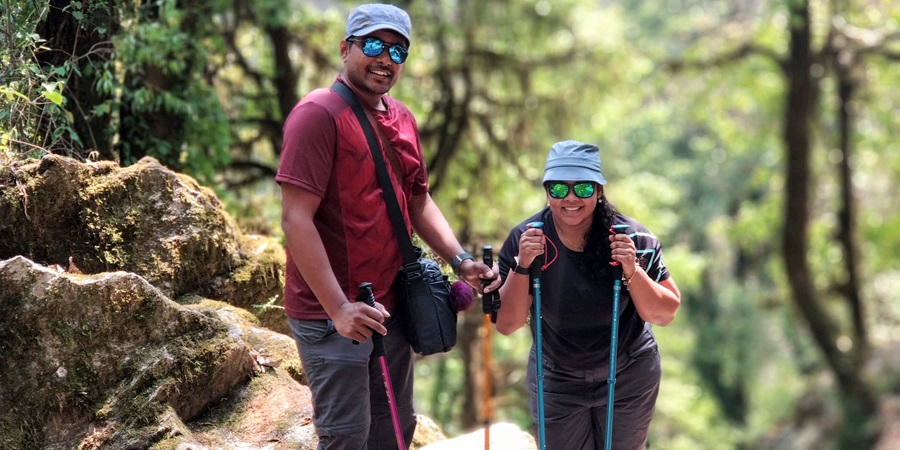
No matter the season you choose for your trek in Nepal, the Annapurna Base Camp Trek stands as a beacon of adventure, set against some of the world’s most awe-inspiring mountainous backdrops.
Each season offers a different perspective of this majestic landscape, ensuring that your journey, with the proper planning and preparation, will be an unforgettable experience to cherish forever.
Whether you seek the blooming rhododendrons of Spring, the clear skies of Autumn, the tranquil solitude of Winter, or the lush vibrancy of Monsoon, the Annapurna Base Camp Trek promises an extraordinary adventure in every step.
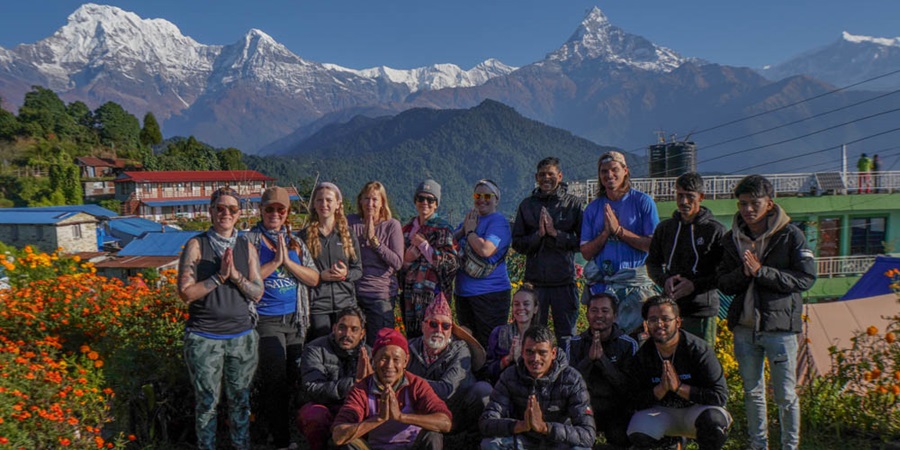
Obtaining Your Permits for the Annapurna Base Camp Trek: ACAP and TIMS
When planning your Annapurna Base Camp Trek, one of the essential preparatory steps is obtaining the necessary permits. This process is a regulatory requirement and a crucial contribution to the sustainability of trekking in Nepal.
The two primary permits required are the Annapurna Conservation Area Permit (ACAP) and the Trekkers’ Information Management System (TIMS) card.
Annapurna Conservation Area Permit (ACAP) for Your Trek in Nepal
- What Is It: The ACAP is a mandatory permit for anyone wishing to trek in the Annapurna Conservation Area, a significant part of your Annapurna Base Camp Trek journey.
- Purpose of ACAP: Obtaining this permit allows you legal access to the conservation area and contributes to the sustainable management of this precious ecosystem.
- Why You Need It: The funds generated from ACAP are instrumental in various conservation and community development efforts within the Annapurna region, making your trek in Nepal a responsible and eco-friendly adventure.

Importance of ACAP in Sustainable Trekking
- Sustainable Development: The revenue from the ACAP is used for vital conservation projects in the Annapurna region. This initiative ensures that the area’s natural beauty and ecological balance are maintained for future generations of trekkers.
- Community Support: A portion of the permit fee is allocated to local community projects. These initiatives enhance the lives of the local inhabitants, ensuring that your Annapurna Base Camp Trek positively impacts the region.
- Trail Maintenance: The ACAP funds also contribute to the maintenance of trekking trails, ensuring they remain safe, clean, and navigable for all trekkers in Nepal.
The Essential TIMS Card for Your Annapurna Base Camp Trek
Embarking on the Annapurna Base Camp Trek is the adventure of a lifetime, and ensuring your safety and security during this journey is paramount. A key element in your trekking preparation is understanding and obtaining the Trekkers’ Information Management System (TIMS) card, an indispensable permit for trekking in Nepal.
What is the TIMS Card?
A Trekking Prerequisite: The TIMS card is mandatory for anyone planning a trek in Nepal, including the iconic Annapurna Base Camp Trek. It serves as a systematic way to record and manage the flow of trekkers throughout the region.
The Purpose of the TIMS Card
- Enhancing Safety: The primary goal of the TIMS card is to bolster the safety and security of trekkers traversing the diverse terrains of the Annapurna region. It’s a crucial tool for efficiently tracking and managing trekkers’ whereabouts.
- Emergency Preparedness: In emergencies, such as natural calamities or accidents, the information stored in the TIMS card is invaluable. It enables quick and effective response from local authorities and rescue teams, ensuring safety.
- Supporting Local Authorities: Obtaining a TIMS card also means aiding the local authorities in regulating and overseeing trekking activities. This support is vital in maintaining the integrity and sustainability of trekking routes in Nepal.
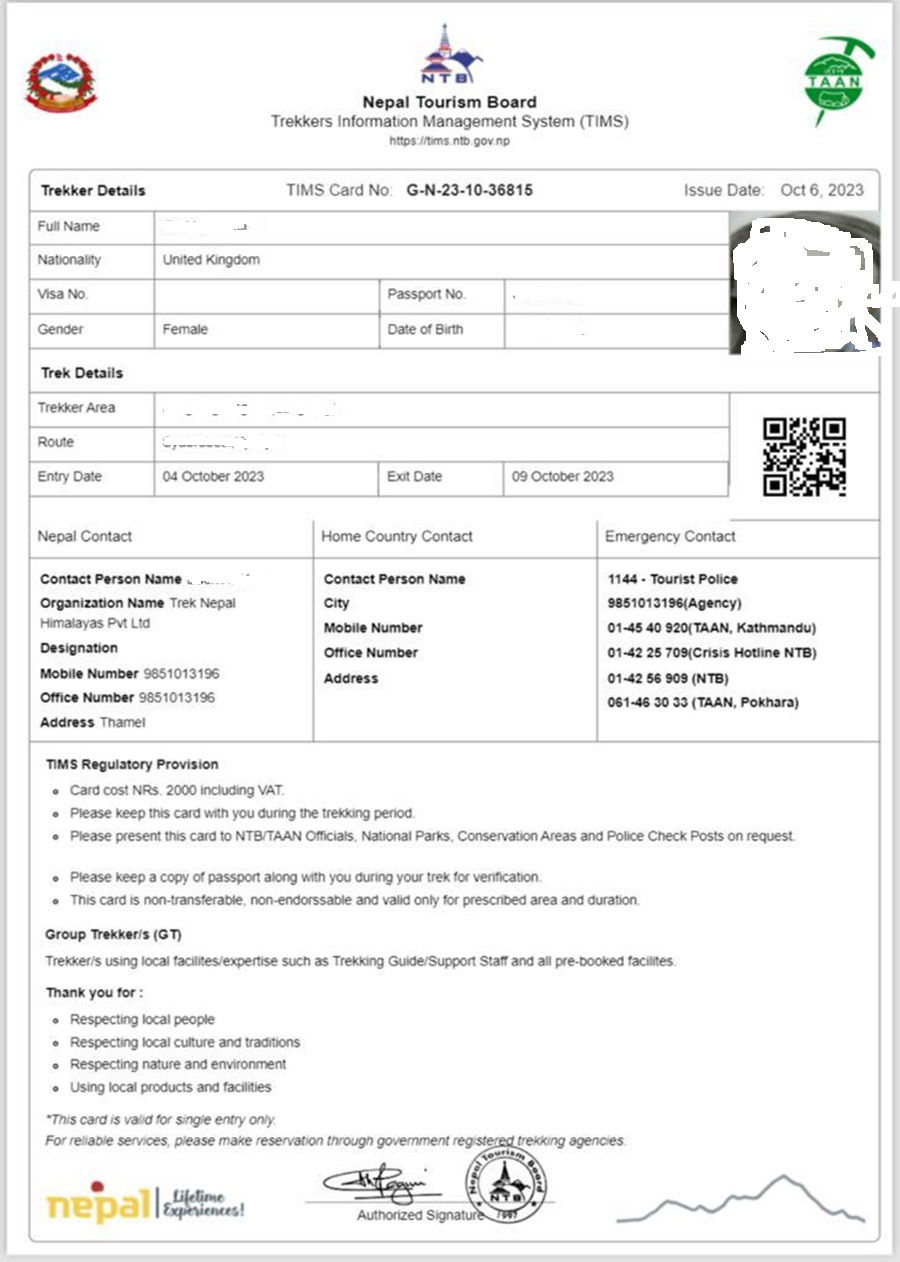
Why You Need the TIMS Card for Your Annapurna Trek
- Safety and Security: The TIMS card is a fundamental component in the safety framework of trekking in Nepal. It ensures that you can be quickly located and assisted in an emergency.
- Contributing to a Better Trekking Experience: By acquiring a TIMS card, you contribute to a well-managed and secure trekking environment. This system benefits you as a trekker and enhances the overall experience for the entire trekking community.
Obtaining your TIMS card is critical in preparing for your Annapurna Base Camp Trek. It’s not merely about adhering to the regulations but about being a responsible trekker who values safety and supports the sustainable management of Nepal’s trekking regions.
As you gear up for your journey, remember that the TIMS card is your partner in ensuring a safe and enjoyable trekking experience, allowing you to immerse fully in the beauty and challenge of the Himalayas.
Obtaining ACAP and TIMS Permits for Your Annapurna Base Camp Trek: Kathmandu and Pokhara Options
A crucial step in preparing for your Annapurna Base Camp Trek is obtaining the necessary permits, namely the Annapurna Conservation Area Permit (ACAP) and the Trekkers’ Information Management System (TIMS) card. These can be acquired in two major cities in Nepal: Kathmandu and Pokhara.

Permit Acquisition in Kathmandu
- Centralized Permit Processing: Kathmandu, the capital city of Nepal, is a primary hub for arranging these permits. You can visit the official tourism offices where ACAP and TIMS permits are readily available.
- Trekking Agencies: If you plan your trek in Nepal through a trekking agency, they typically handle these formalities. Most trekking packages include the acquisition of these permits, making the process convenient and hassle-free for you.
Permit Issuance in Pokhara
- Alternative Location for Permits: Pokhara, often considered the gateway to the Annapurna region, is another convenient place to obtain these permits, especially if you’re starting your trek from this city.
- Benefits of Pokhara: Acquiring permits in Pokhara can be particularly advantageous for trekkers who fly directly to this city or prefer to spend some time there before beginning their trek. The process here is as straightforward as in Kathmandu, with dedicated offices catering to trekkers’ needs.

Documentation and Processing Time for Your Annapurna Base Camp Trek Permits
Proper preparation is critical to a smooth and enjoyable Annapurna Base Camp Trek experience. Part of this preparation involves understanding the documentation requirements and the processing time for the necessary permits, ensuring a hassle-free start to your adventure.
Essential Documentation
- Valid Identification: It is imperative to carry proper identification for your trek in Nepal. Your passport, with a valid Nepalese visa, is essential. This will be required for both the Annapurna Conservation Area Permit (ACAP) and the Trekkers’ Information Management System (TIMS) card applications.
- Passport-Sized Photos: Additionally, ensure you have several passport-sized photos on hand. These are required for the permit applications. Extra images are always a good idea, as they might be helpful for other purposes during your trip.

Allocating Time for Permit Processing
- Processing Duration: Generally, obtaining the ACAP and TIMS permits is a swift process. However, it’s crucial to factor in enough time for this step in your itinerary.
- Recommendation: Allocate at least one day to acquire these permits in Kathmandu or Pokhara. This precautionary measure helps avoid any last-minute complications and gives you a buffer in unexpected delays.
- Avoiding Delays: Planning for this extra time is vital during peak trekking seasons when the permit offices might be busier than usual.
Incorporating a day for permit processing in your Annapurna Base Camp Trek itinerary is a wise decision. This ensures all the necessary documentation is ready and helps start your trek without any unforeseen administrative hiccups.
Proper documentation, including your passport with a valid visa and passport-sized photos, is crucial for a seamless permit process. Remember, meticulous planning is the first step toward an incredible trekking experience in the stunning landscapes of Nepal.
Annapurna Base Camp Trek: Monthly Weather Guide
Regarding trekking in the Annapurna region, weather is pivotal in determining the overall experience. Knowing the monthly weather variations can help you plan your trek more efficiently.
Below is a comprehensive guide detailing the monthly weather conditions for the Annapurna Base Camp Trek.

January Weather for the Annapurna Base Camp Trek: Embracing the Cold
Embarking on the Annapurna Base Camp Trek in January presents a unique set of conditions characterized by the distinct chill of the Himalayan winter.
January Temperatures on the Annapurna Base Camp Trek
- Daytime Conditions: Trekkers can expect daytime temperatures to hover around 5°C. This chilly weather demands appropriate winter gear for a comfortable trekking experience during the day.
- Nighttime Cold: The night temperatures on the Annapurna Base Camp Trek in January often drop below zero, making warm sleeping equipment essential for overnight stays at higher altitudes.
Critical Considerations for a January Trek
- Winter Landscape: The trails will likely be covered in snow, offering a serene and picturesque setting. However, being prepared for snowy paths and potentially tricky terrain is essential.
- Solitude on the Trails: January is a less crowded month for the Annapurna Base Camp Trek, appealing to those seeking a more peaceful and solitary trekking experience.
- Essential Gear: Proper winter trekking gear, including insulated clothing, quality boots, and possibly snow equipment like crampons, is vital for a safe trek.
- Trail Status Updates: Regularly check the status of trails and passes, as some sections might be closed due to heavy snow or avalanche risks.

A January journey on the Annapurna Base Camp Trek offers a tranquil, albeit cold, trekking environment. It’s an ideal time for those who are well-prepared for winter conditions and prefer a quieter trekking experience.
With the right gear and preparation, this month can provide a unique and memorable adventure in the Annapurna region.
February Weather on the Annapurna Base Camp Trek: Transitioning to Spring
As February rolls in, the weather conditions on the Annapurna Base Camp Trek start showing early signs of spring, bringing slight changes in temperatures and trail accessibility.
Temperature in February
- Warmer Days: The temperature in February on the Annapurna Base Camp Trek gets slightly warmer compared to January, with daytime temperatures ranging between 5°C and 10°C. This gradual increase in warmth signals the onset of spring.
- Comfortable Trekking Conditions: The rise in temperature during the day makes trekking more comfortable, especially under the sun.
Considerations for Trekking in February
- Melting Snow: As the month progresses, the snow from winter begins to melt, gradually making the trails more accessible. This is an essential consideration for route planning, as some higher passes may start opening up.
- Fewer Crowds: Similar to January, February is still a relatively quiet month on the trail. This offers an advantage for trekkers seeking a less crowded experience on the Annapurna Base Camp Trek.
- Preparing for Variable Conditions: While the snow starts to recede, trekkers should still be prepared for cold nights and the possibility of encountering snow on higher sections of the trail.
February marks a transitional period on the Annapurna Base Camp Trek, with the weather slowly shifting towards spring.
It’s an ideal time for trekkers who prefer slightly warmer conditions than January and enjoy the tranquillity of the trails with fewer fellow trekkers. Being well-prepared for varying conditions is vital to a successful and enjoyable trek in the Annapurna region.
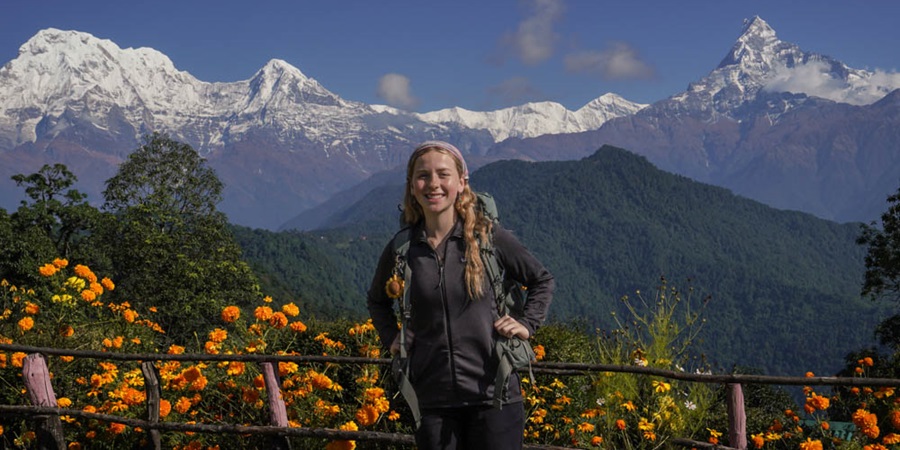
March Weather on the Annapurna Base Camp Trek: The Awakening of Spring
March begins spring on the Annapurna Base Camp Trek, when the landscape starts transforming, offering trekkers a visually stunning experience.
Temperature in March
Moderate Climate: During March, the Annapurna Base Camp Trek experiences a pleasant and reasonable temperature range, typically between 10°C and 15°C. These temperatures create ideal conditions for trekking.
Comfortable Trekking Environment: The daytime weather is warm enough to trek comfortably, while the evenings remain cool but not as cold as the winter months.

Considerations for Trekking in March
- Spring Blossoms: One of the significant highlights of trekking in March is the beginning of the spring bloom. Trekkers will witness the Himalayan landscape come alive with vibrant flowers, especially the famous rhododendrons.
- Stable Weather: March is known for its generally regular weather patterns, with fewer chances of rain and clear skies, providing excellent visibility of the majestic mountains.
- Increasing Popularity: As one of the best months to trek, March gradually increases the number of trekkers on the trail. It’s a great time to experience the Annapurna Base Camp Trek’s social aspect while enjoying spring’s beauty.
Thanks to its moderate temperatures, stable weather, and spectacular spring blossoms, March is highly recommended for the Annapurna Base Camp Trek. This period offers a perfect balance between the natural beauty of the trail and comfortable trekking conditions.
As the trek becomes more prevalent in March, it’s advisable to plan your trip to ensure the availability of accommodations and a seamless trekking experience in the Annapurna region.
April Weather on the Annapurna Base Camp Trek: Spring in Full Swing
April is when spring is in full bloom on the Annapurna Base Camp Trek, offering some of the best trekking conditions of the year.
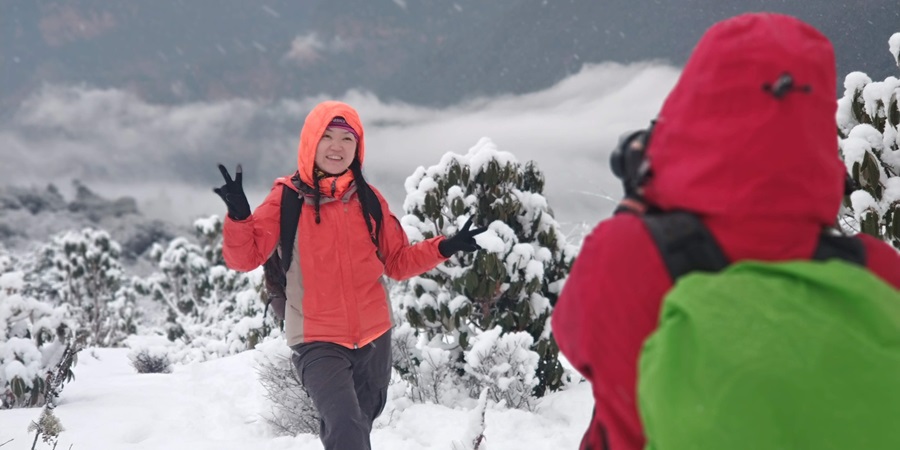
Temperature in April
- Comfortable Range: The temperature in April on the Annapurna Base Camp Trek ranges from a pleasant 10°C to a warmer 20°C. This range provides a comfortable trekking climate, suitable for most trekkers.
- Ideal for Daytime Trekking: The warmer temperatures during the day make for a perfect trekking environment, allowing trekkers to enjoy the journey without the encumbrance of heavy winter gear.
Considerations for Trekking in April
- Clear Skies and Visibility: One of the critical advantages of trekking in April is the likelihood of clear skies, offering unobstructed views of the Himalayan peaks and landscapes.
- Lush Landscapes: As spring is in full swing, the trails and surrounding areas are lush and green, providing a spectacular backdrop for your trek. The rhododendron forests, mainly, are a sight to behold with their vibrant blooms.
- Peak Trekking Season: April is considered one of the best months for the Annapurna Base Camp Trek due to the optimal weather conditions. Consequently, it’s also one of the busiest. Trekkers looking to enjoy the social aspects of the trail will find April ideal, but those seeking solitude may prefer a quieter month.
April stands out as a prime month for the Annapurna Base Camp Trek. With its comfortable temperatures, clear skies, and the beauty of spring in full display, it’s an excellent time for both seasoned trekkers and beginners.
While it is a popular month, attracting more trekkers to the trails, the unparalleled beauty of the Annapurna region in April makes it worth the extra company.
For an optimal experience, early planning and booking are recommended to ensure the best accommodations and services on the trail.
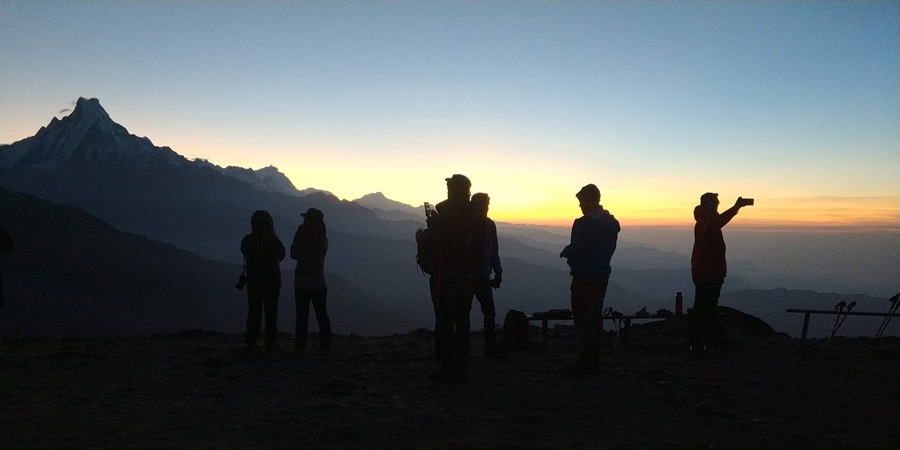
May Weather on the Annapurna Base Camp Trek: Pre-Monsoon Warmth
May is a distinctive time on the Annapurna Base Camp Trek, characterized by pre-monsoon warmth and evolving trail conditions as the region prepares for the upcoming rainy season.
Temperature in May
- Warmer Climate: As May progresses, temperatures on the Annapurna Base Camp Trek typically range from 15°C to 20°C. This warmer weather provides a comfortable trekking environment, though staying hydrated and protected from the sun is essential.
- Pleasant Trekking Conditions: The higher end of the temperature range makes for excellent daytime trekking, but starting early in the day is advisable to avoid the afternoon heat.
Considerations for Trekking in May
- Dusty Trails: With the monsoon rains yet to arrive, the trails in May can be pretty dusty, especially in the lower regions. Having a mask or scarf handy to cover your mouth and nose is a good idea.
- Hazy Skies: The pre-monsoon period often brings overcast skies, which can obscure some mountain views. Despite this, the scenery and landscapes remain impressive.
- Flora and Fauna: May is still a great month to witness the diverse flora and fauna of the region, with many species active and visible before the onset of the monsoon.
Trekking the Annapurna Base Camp Trek in May offers the warmth and vibrancy of the pre-monsoon season. While the trails may be dusty and the skies hazy, the warmer temperatures and active wildlife provide a unique trekking experience.
As always, being prepared for the conditions and respecting the natural environment is crucial to enjoying your journey in the Annapurna region.

June Weather on the Annapurna Base Camp Trek: Arrival of the Monsoon
June marks the onset of the monsoon season on the Annapurna Base Camp Trek, bringing a significant shift in the weather pattern and trekking conditions.
Temperature in June
- Warm and Humid Climate: The temperatures in June along the Annapurna Base Camp Trek are warm, usually between 15°C and 20°C. However, the humidity levels also rose this month, making it feel more generous than the actual temperature.
- Balmy Trekking Conditions: While trekking during the day, it’s essential to be prepared for the humid conditions, often accompanied by sporadic rainfall.
Considerations for Trekking in June
- Rainfall and Trail Conditions: As the monsoon season begins, trekkers should expect regular rain, leading to slippery trails and leeches. Waterproof gear, including raincoats and trekking boots with good grip, becomes essential.
- Adventurous Trekking Experience: June can be a challenging month for trekking, but it’s also an opportunity for adventure seekers who don’t mind the rain and are prepared for the monsoon conditions.
- Lush Greenery: The monsoon rains rejuvenate the landscapes, turning them lush and vibrant. It’s a great time to experience the rich biodiversity of the Annapurna region in its full glory.
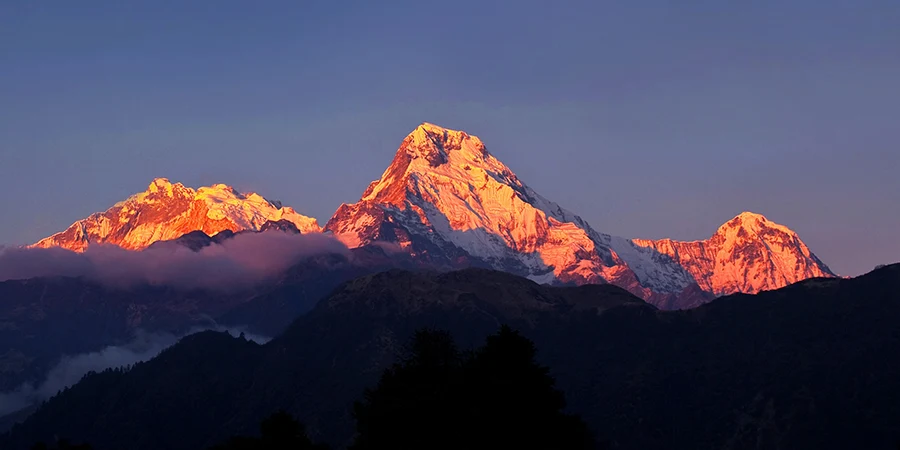
In June, the Annapurna Base Camp Trek is for those ready to embrace the monsoon and its challenges. The warm but humid weather and the likelihood of rain make this month suitable for adventurous trekkers.
With the right gear and a flexible mindset, trekking during the monsoon can be a rewarding and unique experience, offering a different perspective of the Annapurna region’s natural beauty.
July Weather on the Annapurna Base Camp Trek: The Peak of Monsoon
July in the Annapurna Base Camp Trek epitomizes the peak monsoon season in Nepal, presenting unique challenges and experiences for trekkers.
Temperature in July
- Warm and Humid Conditions: The climate throughout July on the Annapurna Base Camp Trek remains consistently warm, with temperatures fluctuating between 15°C and 20°C. The high humidity during this time further accentuates the warmth.
- Steady Climate for Trekking: Despite the warmth, the consistently humid conditions require trekkers to be prepared for a muggy atmosphere, especially during the daytime.
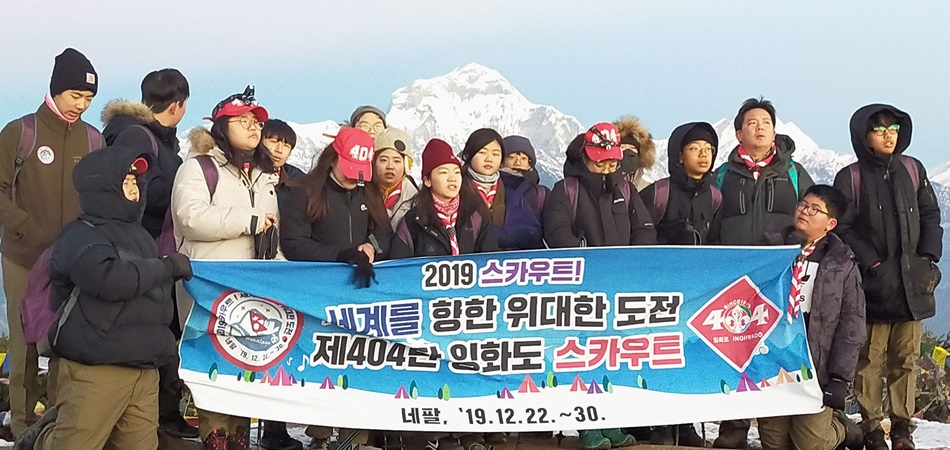
Considerations for Trekking in July
- Expect Heavy Rains: July is characterized by heavy and frequent rainfall, which can lead to very wet and slippery trail conditions. This requires careful planning and appropriate monsoon trekking gear.
- Challenges on the Trail: The roads can become muddy and challenging due to the rains. There’s also an increased likelihood of encountering leeches.
- Less Crowded Trails: As the least popular month for trekking, July offers a solitary experience for those who venture onto the trails. This can appeal to trekkers seeking solitude and a more personal connection with nature.
- Lush Environment: The monsoon rains transform the Annapurna region into a verdant paradise, offering stunningly lush landscapes unique to this season.
Trekking the Annapurna Base Camp Trek in July is for the intrepid adventurer who doesn’t mind the challenges posed by the monsoon. The journey during this time offers a distinct experience characterized by lush greenery and fewer fellow trekkers.
It’s essential to be well-equipped for the wet conditions and to have a flexible attitude towards the unpredictable weather patterns of the peak monsoon season.

August Weather on the Annapurna Base Camp Trek: The Tail End of Monsoon
August on the Annapurna Base Camp Trek marks the gradual transition out of the monsoon season, offering a mix of weather patterns as the region prepares for autumn.
Temperature in August
- Consistent Warmth: For most of August, the Annapurna Base Camp Trek temperatures are similar to those in June and July, remaining warm and humid between 15°C and 20°C.
- Cooling Trend: As the month progresses, there’s a noticeable shift in the weather, with temperatures starting to cool down, hinting at the approaching end of the monsoon season.
Considerations for Trekking in August
- Drying Trails: With the monsoon tapering off, the trails dry up, making them easier to navigate than in the earlier monsoon months. However, trekkers should still be prepared for muddy sections and residual slipperiness.
- Expect Occasional Rain Showers: While the heavy rains start to subside, occasional showers are still common, so carrying waterproof gear remains essential.
- Less Crowded Paths: Like July, August is less famous for trekking, so the trails are less crowded. This offers a more solitary experience in the beautiful Annapurna region.
- Lush Greenery: The landscapes continue to be dense and vibrant, with the monsoon rains leaving behind a refreshed and rejuvenated environment.
Trekking the Annapurna Base Camp Trek in August presents an opportunity to experience the last of the monsoon’s lushness combined with the start of drier conditions.
This month is ideal for trekkers who are flexible with occasional rains and prefer quieter trails. As the month progresses, the changing weather provides a glimpse into the upcoming autumn season, making it a unique time to explore the Annapurna region.

September Weather on the Annapurna Base Camp Trek: The Start of Autumn
September signifies the beginning of autumn on the Annapurna Base Camp Trek. This month brings a notable shift in weather and scenery, making it one of the region’s most favoured times for trekking.
Temperature in September
- Pleasant Climate: The Annapurna Base Camp Trek experiences a pleasant climate in September, typically between 10°C and 15°C. These conditions provide a comfortable trekking atmosphere, neither too hot nor too cold.
- Ideal for Day Hikes: The temperate weather during the day makes for ideal hiking conditions, allowing trekkers to enjoy the trails in comfort.

Considerations for Trekking in September
- Post-Monsoon Clarity: Following the monsoon season, the air in September is crisp and clear, offering excellent visibility. This clarity provides trekkers with some of the most spectacular views of the Annapurna range.
- Lush Landscapes: The recent monsoon rains leave the landscapes lush and green. Trekkers will be treated to vibrant forests and rejuvenated flora, adding to the scenic beauty of the trek.
- Increasing Popularity: As one of the preferred months for trekking, September sees an increase in the number of trekkers on the Annapurna Base Camp Trek. The trail becomes more social and lively, offering an excellent opportunity to meet fellow trekking enthusiasts.
September marks a beautiful time to embark on the Annapurna Base Camp Trek. The combination of pleasant temperatures, clear skies, and lush post-monsoon landscapes makes it an attractive month for trekkers.
It’s an excellent time to experience the Annapurna region’s natural beauty and cultural richness in a more vibrant and dynamic setting. Early planning is recommended to make the most of this popular trekking season.
October Weather on the Annapurna Base Camp Trek: The Peak of Trekking Season
October is the pinnacle of the trekking season on the Annapurna Base Camp Trek, offering some of the most ideal conditions for an unforgettable trekking experience.

Temperature in October
- Mild and Enjoyable Climate: During October, the Annapurna Base Camp Trek is graced with mild temperatures, typically between 10°C and 15°C. This range is perfect for trekking, as it is neither too hot during the day nor too cold at night.
- Optimal Daytime Trekking: The daytime temperatures are exceptionally favourable, providing a comfortable atmosphere for long treks and exploration.
Considerations for Trekking in October
- Clear Skies and Great Visibility: One of the major attractions of trekking in October is the clear skies, offering excellent visibility. This is the time when the views of the Annapurna mountain range are at their most spectacular.
- Stable Weather Conditions: The weather in October is generally harsh, with minimal rainfall, contributing to safer and more predictable trekking conditions.
- High Popularity: As the most popular month for the Annapurna Base Camp Trek, October attracts many trekkers worldwide. This creates a lively and friendly atmosphere on the trails.
- Advance Planning Required: Planning your trek is wise due to its popularity. Booking accommodations and arranging guides or porters ahead of time is recommended to ensure a smooth trekking experience.
October is the prime time for the Annapurna Base Camp Trek, characterized by its mild climate, clear skies, and stable weather. It’s the perfect month for those looking to experience the trek with all its natural beauty and cultural vibrancy in full swing.

While the trails are busier, the chance to meet fellow trekkers and enjoy the best of the Annapurna region’s conditions makes it an enriching time for the trek.
November Weather on the Annapurna Base Camp Trek: Embracing Late Autumn
November in the Annapurna Base Camp Trek is characterized by the late autumn charm, offering stable weather with a gradual transition towards the colder temperatures of winter.
Temperature in November
- Cooler Range: The temperatures during November on the Annapurna Base Camp Trek tend to be more relaxed, ranging from 10°C to 15°C. This range provides a crisp and refreshing trekking experience.
- Comfortable Trekking Conditions: Despite the cooler air, the daytime temperatures remain comfortable, with trekkers enjoying the clear and crisp autumn days.
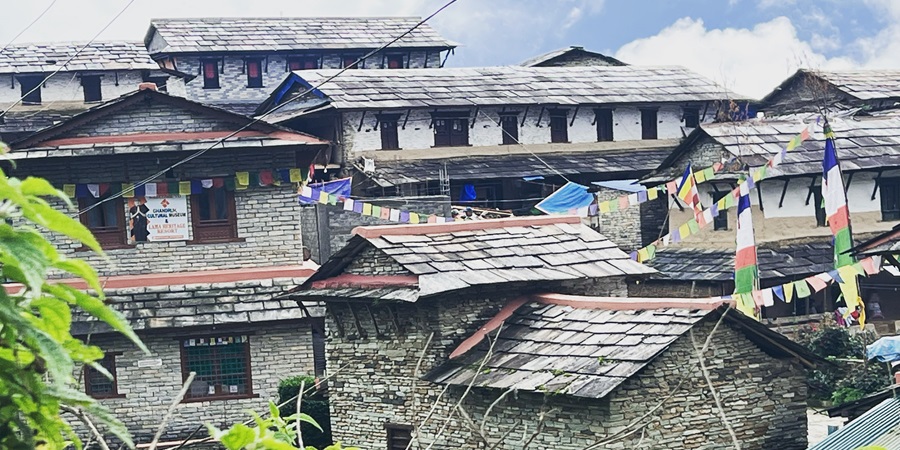
Considerations for Trekking in November
- Stable Weather: Early November continues to enjoy the challenging weather conditions typical of autumn, making it a favourable time for trekking.
- Gradual Cooling: As the month progresses, the weather starts getting colder, especially towards the end of November, signalling the approach of winter. Trekkers should be prepared for colder nights and mornings.
- Changing Scenery: The landscapes in November change, with the lush greenery of earlier months giving way to the more muted tones of late autumn.
- Fewer Crowds: With the peak season winding down, November sees fewer trekkers on the trail than October. This can be appealing to those seeking a more tranquil trekking experience.
November is a beautiful time for the Annapurna Base Camp Trek, offering the last glimpses of autumn with the added advantage of fewer crowds. The cooler temperatures and stable weather conditions make it an excellent month for trekkers who enjoy the serenity of the trails and the crispness of late autumn.
As always, adequate preparation for the varying temperatures is vital to a comfortable and enjoyable trekking experience in the Annapurna region.
December Weather on the Annapurna Base Camp Trek: The Onset of Early Winter
December on the Annapurna Base Camp Trek marks the beginning of the winter season, bringing a distinct change in the weather and trekking environment.

Temperature in December
- Cooler Climate: The temperatures in December are similar to those in January, albeit slightly warmer, usually ranging between 5°C and 10°C. This range indicates the onset of early winter conditions on the trek.
- Chilly Trekking Atmosphere: While the days can be moderately cool, making daytime trekking feasible, the temperatures can drop significantly during the evenings and mornings.
Considerations for Trekking in December
- Reduced Crowds: One of the advantages of trekking in December is the smaller number of trekkers on the trail. This offers a more solitary and peaceful trekking experience in the Annapurna region.
- Colder Weather Preparation: Trekkers should be well-prepared for the colder temperatures. This includes having proper winter gear, such as insulated clothing, good-quality sleeping bags, and appropriate footwear.
- Potential Snowfall: Snowfall is possible, especially at higher altitudes. While this can add to the scenic beauty of the trek, it also means trekkers should be prepared for snow-covered trails and colder conditions.
- Shorter Days: With winter setting in, the daylight hours are more straightforward, so it’s essential to plan your trekking itinerary accordingly to make the most of the daylight.
In its early winter glory, December presents a unique opportunity to experience the Annapurna Base Camp Trek. The cooler temperatures and potential for snowfall, combined with fewer crowds, make it an appealing time for trekkers who enjoy a quieter and more serene mountain environment.
Adequate preparation for winter conditions is essential to ensure a safe and enjoyable trek this month. Whether you prefer trekking in the busy peak seasons of Spring and Autumn, or you’re looking to embrace the solitude of Winter or the challenges of Monsoon, this monthly guide aims to equip you with the weather insights you need for a successful Annapurna Base Camp Trek.
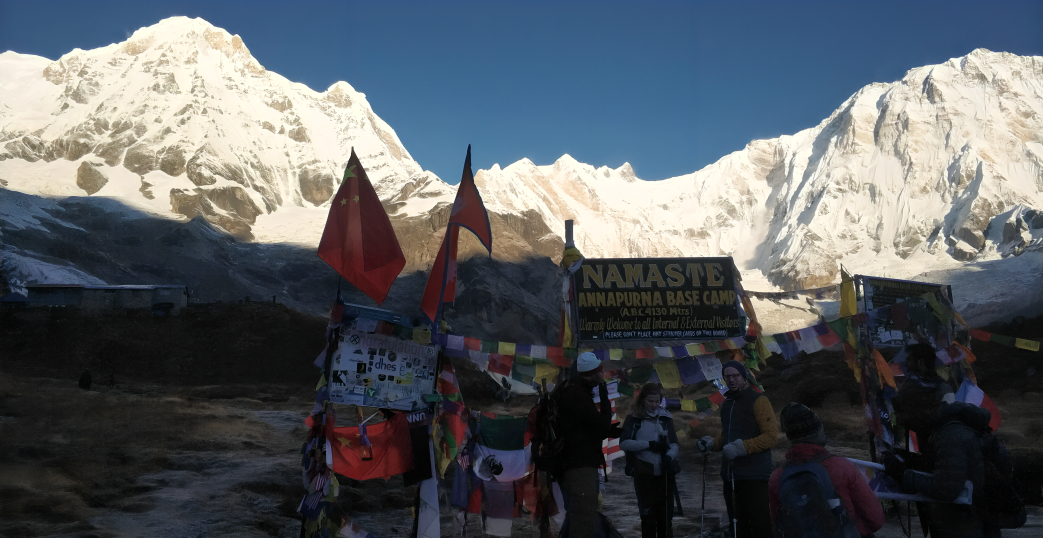
Teahouse Accommodations on the Annapurna Base Camp Trek: A Guide for Trekkers
When embarking on the Annapurna Base Camp Trek, one of the crucial aspects of your planning should be accommodation. The Annapurna trail offers the unique experience of staying in teahouses, providing comfort and convenience to trekkers.
What is a Teahouse on the Annapurna Base Camp Trek?
- Definition and Essence: A teahouse is a type of lodge run by locals, providing basic lodging and meals to trekkers on the Annapurna Base Camp Trek. These establishments are more than just accommodations; they offer a glimpse into the local Himalayan culture and lifestyle.
Types of Teahouses Along the Annapurna Trail
- Basic Teahouses: Characterized by minimal amenities such as communal sleeping spaces, shared bathrooms, and limited food choices. These are budget-friendly options, often in quieter Annapurna Base Camp Trek regions.
- Moderate Teahouses: These balance comfort and authenticity, offering private rooms, often with attached bathrooms, and a broader menu selection.
- Luxury Teahouses: While rare, luxury teahouses are available in some parts of the trek, featuring amenities like hot showers, western toilets, and diverse menu options, catering to trekkers looking for more comfort on their journey.
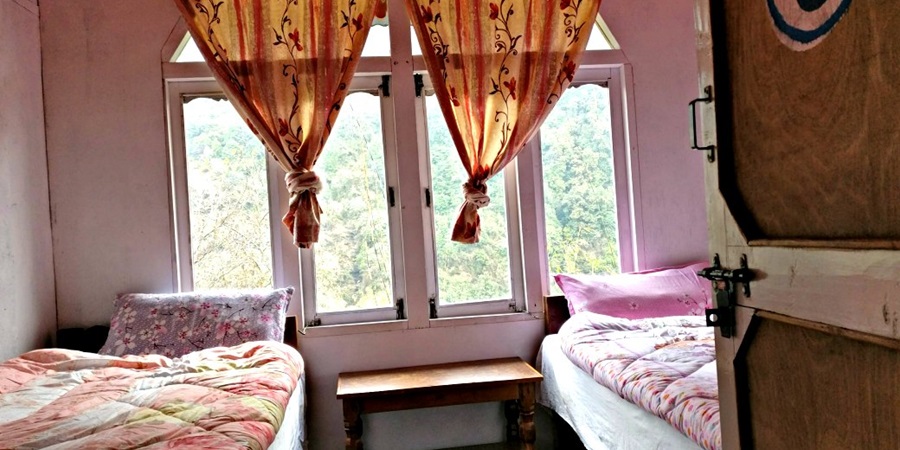
Key Features of Teahouses on the Annapurna Base Camp Trek
- Accommodation Style: Typically, teahouses have double occupancy rooms, with the option for single rooms at a higher cost.
- Facilities: Most teahouses offer shared bathrooms, while higher-end ones may provide private bathrooms.
- Dining: The culinary experience in teahouses ranges from traditional Nepalese meals like Dal Bhat to some international dishes.
- Utilities: Charging for electronic devices and WiFi access are often available for an additional fee, though reliability can vary due to the remote locations.
Teahouse accommodations are an integral part of the Annapurna Base Camp Trek experience. They provide a place to rest and refuel and offer an opportunity to immerse in the local culture.
From essential to luxury, these teahouses cater to a range of trekker needs, ensuring everyone can find a suitable place to stay while exploring the majestic Annapurna region.
Annapurna Base Camp Trek: A Trekker’s Guide to Food
Food plays a pivotal role in the trekking experience of the Annapurna Base Camp Trek, offering both sustenance and a chance to delve into the region’s rich cultural tapestry through its diverse culinary offerings.

Delving into Nepali Cuisine: A Trekker’s Delight
- Dal Bhat Power: The quintessential Nepali meal, Dal Bhat, is a staple for trekkers on the Annapurna Base Camp Trek. This hearty and nutritious meal typically includes lentil soup, steamed rice, and a variety of side dishes like vegetable curry, pickle, and sometimes meat curries. It’s known for its energy-sustaining properties, perfect for long trekking days.
- Momo – A Popular Treat: These delicious Nepali dumplings, filled with either meat or vegetables, are a favourite among trekkers. Available in most teahouses, momos are a perfect snack or meal to satisfy your hunger on the trail.
- Gundruk – A Taste of Tradition: This dish of fermented leafy greens is a traditional delicacy in the mountain regions. High in nutrients and served as a side, Gundruk adds a unique flavour to meals and is a must-try for those seeking authentic local tastes.
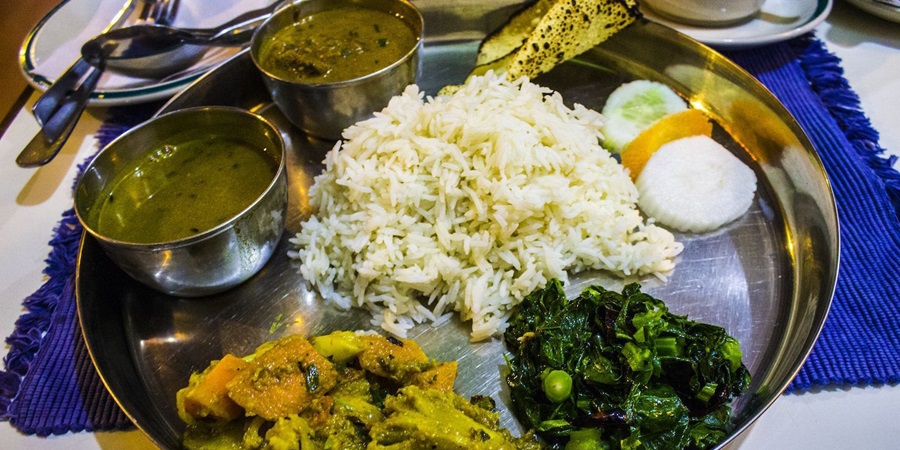
International Cuisine: Comfort Food on the Trail
- Pasta and Noodles: For those craving a taste of home, many Annapurna Base Camp Trek teahouses offer a range of pasta and noodle dishes, from spaghetti Bolognese to hearty vegetable stir-fries.
- Pizza in the Mountains: While it may differ from the classic Italian pizza, the pizzas available at higher altitudes are surprisingly satisfying and a great way to indulge in some Western cuisine.
- Morning Delights: Start your trekking day with familiar breakfast options like pancakes and toast, complemented with honey, jam, or eggs, available at most teahouses along the route.
Snacks and Refreshments: Energy Boosters and Hydration
- Energy Bars and Snacks: Carrying high-energy snacks like energy bars, granola bars, or dried fruits is recommended for quick nourishment during trekking.
- Fresh Fruits: Teahouses often offer fresh fruits like apples and bananas, providing a healthy and refreshing snack.
- Hot Drinks for Cold Evenings: Enjoy a selection of hot beverages, including local tea, coffee, and hot chocolate. Trying local herbal teas is also a great way to immerse yourself in the local culture.

Accommodating Dietary Needs: Vegetarian, Vegan, and Gluten-Free
- Vegetarian and Vegan Options: The Annapurna Base Camp Trek is vegetarian and vegan-friendly, with many teahouses offering a variety of plant-based meals.
- Gluten-Free Needs: Though not as prevalent, some teahouses can cater to gluten-free diets if notified beforehand.
The culinary experience on the Annapurna Base Camp Trek is as diverse and rewarding as the trek itself. From the energy-packed local dishes to comforting international cuisine, the food options along the trek cater to a wide range of tastes and dietary requirements, ensuring that your trek is an adventure for the senses and a journey of culinary discovery.
Safe Drinking Water Options on the Annapurna Base Camp Trek
Proper hydration is vital for a successful and enjoyable experience on the Annapurna Base Camp Trek. At Trek Nepal Himalayas Pvt Ltd, we prioritize your health and safety, particularly regarding water consumption.
Here’s what you need to know about staying hydrated and ensuring safe drinking water on the trek.

Water Sources on the Annapurna Base Camp Trek
- Natural Springs: While the trail has natural springs, treating this water before drinking is crucial to avoid contamination.
- Teahouses: You will find that most teahouses along the Annapurna Base Camp Trek provide bottled and boiled water for drinking.
- Local Stores: Along the route, small stores sell bottled water. However, be aware that prices tend to increase with higher altitudes.
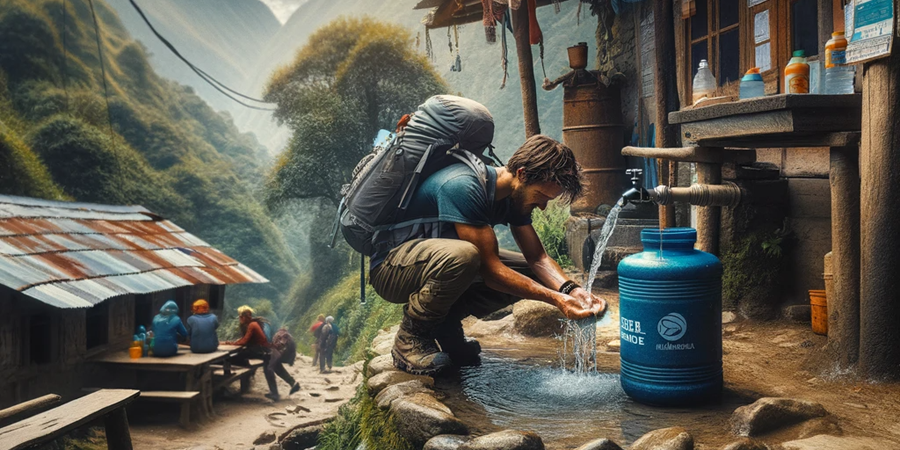
Safe Drinking Water Options
- Bottled Water: A convenient choice, but not the most sustainable. If bottled water is used, we encourage trekkers to reuse and dispose of it responsibly at recycling points.
- Boiled Water: A popular option among trekkers, available at teahouses. Boiling is a dependable method to purify water.
- Water Purification Tablets: Lightweight and straightforward, these tablets purify water within a specified time and are a good alternative.
- UV Sterilizers: Portable devices that use UV light to eliminate bacteria and viruses, offering a high-tech solution for water purification.
- Filtered Water Bottles: These bottles come with built-in filters and are convenient, though they have a limited capacity.
Tips for Staying Hydrated
- Carry Sufficient Water: Always take 1-2 litres when departing from a village or teahouse.
- Drink Regularly: Consume water at consistent intervals rather than in large quantities at once.
- Avoid Dehydrating Beverages: Limit or avoid alcohol and caffeine, as they can lead to dehydration. Opt for water and herbal teas.
- Proactive Hydration: Drink water regularly before feeling thirsty, especially at high altitudes where thirst perception may decrease.
- Know the Next Water Source: Always inquire about the availability of the next water source from your guide or the teahouse staff.

At Trek Nepal Himalayas Pvt Ltd, we’re committed to ensuring trekkers on the Annapurna Base Camp Trek stay well-hydrated with safe drinking water.
Trust our expertise to guide you through your trek, focusing on hydration safety so you can fully enjoy the magnificent sights and experiences of the Annapurna region.
Hot Shower Amenities on the Annapurna Base Camp Trek: Essential Comforts for Trekkers
Trekking the Annapurna Base Camp Trek is an exhilarating experience, and having access to hot shower facilities adds a touch of comfort to this adventurous journey.
At Trek Nepal Himalayas Pvt Ltd, we understand the significance of these amenities in enhancing your trekking experience. Here’s a detailed guide on what to expect regarding hot showers along the trail.
Hot Shower Options on the Annapurna Trail
- Teahouse Shower Facilities: Most teahouses along the Annapurna Base Camp Trek route offer hot shower facilities. These showers are usually in separate rooms equipped with hot water, providing a welcome respite after a day of trekking.
- Eco-friendly Solar-Powered Showers: In line with sustainable practices, several teahouses use solar power to heat water. While dependent on weather conditions, these offer an environmentally friendly shower option.
- Traditional Bucket Showers: At higher altitudes or remote teahouses, bucket showers are shared. Hot water is provided in buckets, offering a simple yet effective way to bathe.

Availability Across the Trek Route
- Lower Altitude Teahouses: In the lower regions of the Annapurna Base Camp Trek, hot showers are generally more accessible and often included in the accommodation cost.
- Higher Altitudes: As you trek higher, hot showers might incur an additional fee. Despite this, they are typically available, allowing for comfort even in the more elevated sections of the trek.
- Advance Arrangements: Our trek packages include bookings at teahouses with reliable hot shower facilities, ensuring this comfort is available throughout your journey.
Tips for a Better Shower Experience
- Best Time to Shower: Showering upon reaching your teahouse ensures better access to hot water, as it can be limited later in the evening.
- Water Conservation: We encourage trekkers to use water judiciously, especially at higher altitudes with scarce resources.
- Using Eco-friendly Products: Bring biodegradable soap and shampoo to minimise environmental impact.
- Inquire Ahead: Check with your teahouse about hot shower availability and any extra charges, particularly in the higher altitude areas.
Experience the added comfort of hot showers while you explore the breathtaking landscapes of the Annapurna Base Camp Trek.
With Trek Nepal Himalayas Pvt Ltd, you can enjoy these small luxuries that make a significant difference in your overall trekking experience, ensuring you’re refreshed and rejuvenated each day of your adventure.

Toilet Facilities and Options During the Annapurna Base Camp Trek
For trekkers embarking on the Annapurna Base Camp Trek, understanding the available toilet facilities is crucial for a comfortable journey.
Trek Nepal Himalayas Pvt Ltd is committed to providing detailed information on the sanitation options you’ll encounter along the trail and in the teahouses.
Diverse Toilet Facilities in Teahouses
- Western-Style Toilets: In many teahouses at lower altitudes of the Annapurna Base Camp Trek, trekkers can find Western-style toilets. These facilities typically include flush mechanisms and are a welcome comfort for many trekkers.
- Squat Toilets: Higher up the trail, squat toilets are more common. While essential, they are functional and a part of the authentic trekking experience.
- Ensuite vs. Shared Facilities: Lower elevations might offer the luxury of ensuite bathrooms in teahouses, but shared facilities become the norm as you trek higher.
- Sanitation Essentials: It’s recommended to carry your toilet paper. While washing facilities are usually present, bringing hand sanitiser enhances your hygiene.
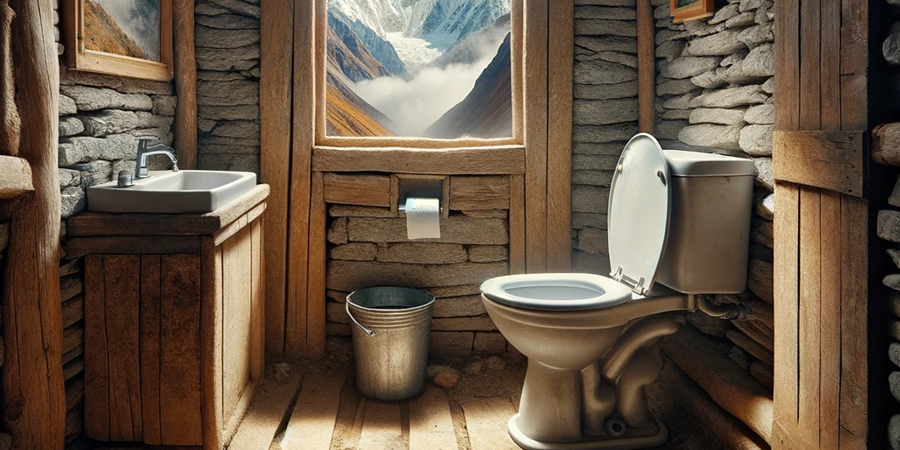
Toilet Accessibility While Trekking
- Natural Breaks: In remote stretches with no teahouses, ‘natural breaks’ in discreet locations are the norm. Trekkers are advised to be environmentally responsible during such breaks.
- Temporary Toilets: Some Annapurna Base Camp Trek sections may have temporary toilets. These basic setups are meant to cater to trekkers and vary in cleanliness.
Tips for a Hassle-Free Experience
- Hygiene Supplies: Essential items like toilet paper, wet wipes, and hand sanitiser should be part of your trekking kit.
- Eco-Friendly Practices: Dispose of waste responsibly or carry it until you find a suitable disposal point to minimize environmental impact.
- Morning Rush Hour: Plan your toilet use around peak times, especially in the morning, to avoid queues at shared facilities.
- Expert Advice: Always consult your trekking guide about upcoming toilet facilities to manage your breaks effectively.
Understanding the toilet facilities on the Annapurna Base Camp Trek is an essential aspect of trek preparation. From the comfort of Western-style toilets at lower altitudes to more rudimentary options as you ascend, being prepared makes a significant difference.
Trek Nepal Himalayas Pvt Ltd ensures that you have all the necessary information for a comfortable trekking experience so you can focus on the breathtaking beauty of the Annapurna region.
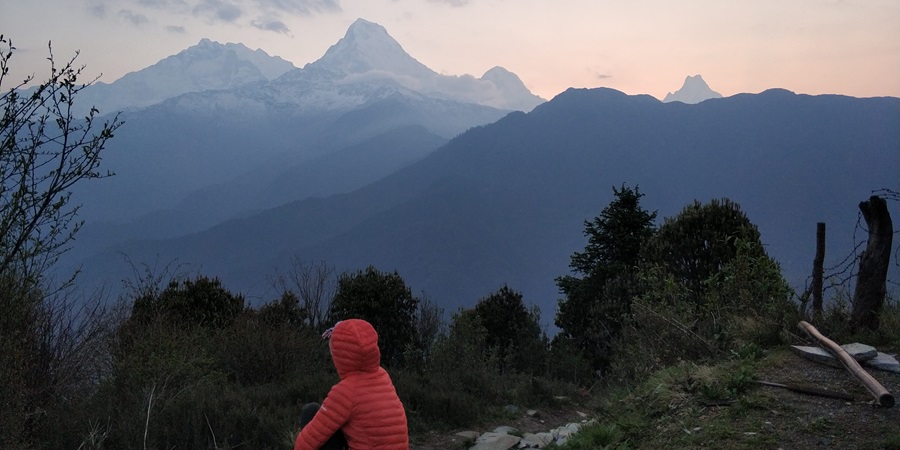
Electricity and WiFi Access on the Annapurna Base Camp Trek
For modern trekkers embarking on the Annapurna Base Camp Trek, access to electricity and WiFi is not just a luxury but often a necessity. Trek Nepal Himalayas Pvt Ltd understands the importance of staying connected and powered up. Here’s what you can expect regarding electricity and WiFi availability during your trek.
Electricity Availability on the Trek
- Lower Altitudes: At lower elevations along the Annapurna Base Camp Trek, most teahouses offer reliable electricity, making it easier to charge devices such as cameras and smartphones, usually at no extra cost.
- Higher Altitudes: As you ascend, electricity becomes a scarce resource. It’s common to pay about $2 to $5 per hour to charge devices in these higher regions.
- Solar Charging: Some higher-altitude teahouses rely on solar power for electricity. Therefore, availability can be weather-dependent.
- Power Banks: Given the varying availability and additional cost of electricity, carrying a power bank is highly recommended to ensure your devices remain charged throughout the trek.
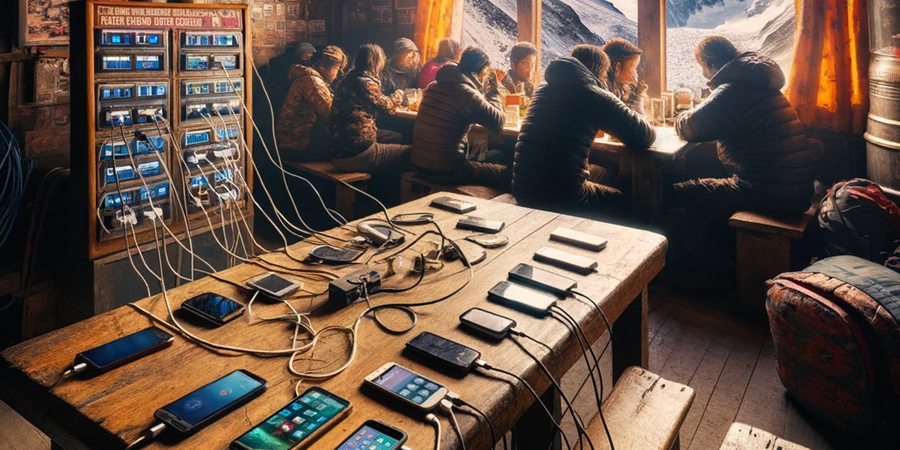
WiFi Connectivity Along the Trail
- In Lower Regions: WiFi is generally available in most teahouses in the lower altitudes, sometimes complimentary or for a small fee of about $1 to $3.
- At Higher Altitudes: The reliability and cost of WiFi change as you trek higher. Some remote teahouses may charge up to $5 for limited access.
- Data Cards: Purchasing a local mobile internet data card is an alternative, though network coverage tends to be inconsistent in higher regions.
- Bandwidth Limitations: Available WiFi usually offers limited speed and bandwidth, suitable for basic browsing and messaging but not for streaming or heavy data usage.
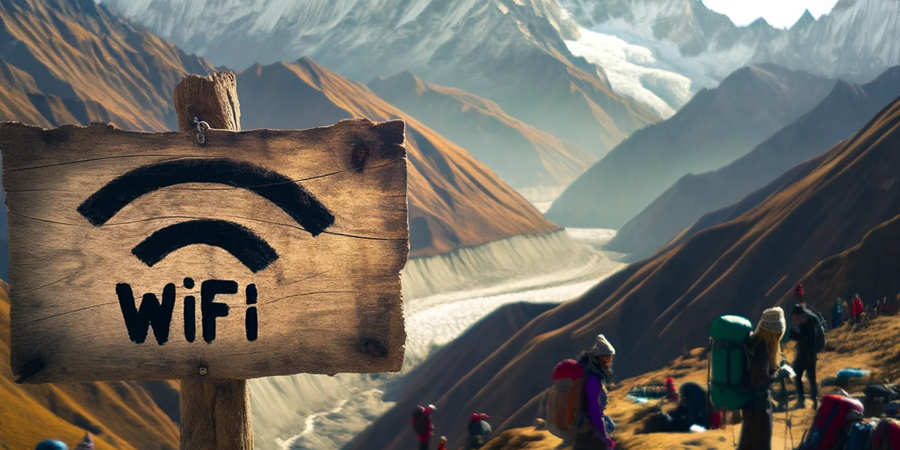
Additional Tips for Trekkers
- Prepare for Off-Grid Areas: Expect parts of your trek to be off-grid. Pre-download maps and carry extra batteries for essential devices.
- Eco-Conscious Use of Resources: Conserve energy by turning off lights and unplugging devices when not in use, especially in areas where power is generated through eco-friendly means.
- Guidance on Availability: Consult with your trekking guide about the availability and reliability of electricity and WiFi at your upcoming stops.
Navigating the availability of electricity and WiFi on the Annapurna Base Camp Trek requires some planning and preparation.
While these amenities are available in most parts of the trek, they become less frequent and more costly as you gain altitude.
Trek Nepal Himalayas Pvt Ltd is committed to providing trekkers with all the necessary information to ensure a comfortable and enjoyable trekking experience in the stunning Annapurna region.
The Essentiality of Travel Insurance and Evacuation Coverage for the Annapurna Base Camp Trek
Trekking the Annapurna Base Camp Trek is an adventure with its share of risks due to the remote and high-altitude terrain. Recognizing the importance of being prepared for unforeseen health and safety incidents.
Trek Nepal Himalayas Pvt Ltd emphasizes the need for comprehensive travel insurance and evacuation coverage. Here’s why it’s critical and what to consider:

Vital Coverage Types for Trekkers
- Medical Insurance: Select a policy that provides robust medical coverage. This should include expenses for hospitalization and treatment in case of sudden illnesses or injuries.
- Helicopter Evacuation: Given the remote nature of many Annapurna Base Camp Trek areas, helicopter evacuation may be necessary in emergencies. Ensure this is included in your insurance plan.
- Trip Cancellation and Delays: Insurance that covers cancellations and delays can save you from financial loss due to unforeseen events impacting your travel plans.
- Protection for Personal Items: While not as urgent as medical or evacuation coverage, insurance for lost or stolen personal items adds an extra layer of security.
Importance of Insurance on the Trek
- High Altitude Risks: The risk of altitude sickness and its severe complications necessitates immediate medical attention, which is covered by a good insurance policy.
- Limited Medical Facilities: Remote trekking routes have scarce medical facilities. Quick access to care, often requiring helicopter services, is crucial.
- Unpredictable Accidents: Insurance ensures you receive prompt and appropriate medical treatment for any injuries without the cost of stress.
- Financial Safeguard: The high cost of medical evacuations can be financially overwhelming. Adequate insurance provides critical financial protection.
Considerations When Choosing a Policy
- Comprehensive Policy Review: Understand the specifics of your policy, including high-altitude trekking coverage and emergency evacuation provisions.
- Direct Payment Facility: Opt for an insurance policy that directly pays the service providers, avoiding the need for upfront payments on your part.
- Policy Validity: Ensure your insurance covers the entire duration of your trek, with some buffer days for any unforeseen changes in your itinerary.
- Insurer’s Network: A policy from an insurer with a vast network, both globally and in Nepal, facilitates smoother coordination during emergencies.

Investing in a comprehensive travel insurance policy is a critical step in your preparation for the Annapurna Base Camp Trek. With Trek Nepal Himalayas Pvt Ltd, your safety and well-being are paramount.
We strongly advise securing an all-encompassing insurance plan before setting off on this remarkable journey to ensure peace of mind and security throughout your adventure.
Financial Planning for the Annapurna Base Camp Trek: A Trekker’s Guide
Embarking on the Annapurna Base Camp Trek is an adventure of a lifetime. Still, it also requires savvy financial planning due to the limited banking facilities and variable acceptance of credit cards.
At Trek Nepal Himalayas Pvt Ltd, we offer a detailed guide to help you manage your finances smoothly during your trek.
Money Exchange Essentials
- Best Exchange Rates in Cities: Before starting your trek, exchange currency in major cities like Kathmandu and Pokhara, where numerous authorized exchange counters offer favourable rates.
- Scarce Options in Remote Areas: As you trek further into remote regions, currency exchange services become rare and offer less favourable rates.
- Necessity of Local Currency: Carrying enough Nepali Rupees is essential, as foreign currencies are generally not accepted beyond significant cities.
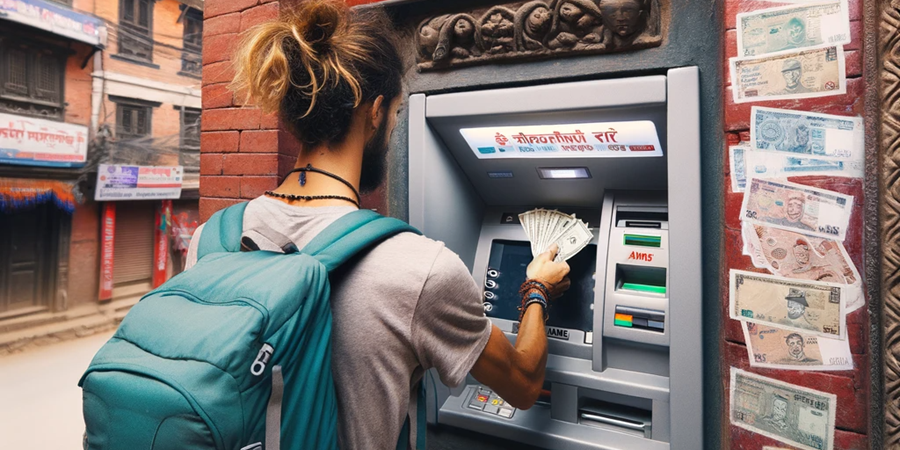
ATM Services Along the Trek
- Urban Availability: While ATMs are easily accessible in Kathmandu and Pokhara, their availability decreases significantly as you venture into the trek.
- Withdrawal Limits and Fees: ATMs typically have a withdrawal limit of around 40,000 NPR per transaction, costing about 700 NPR.
- Strategic Withdrawals: Plan your ATM withdrawals to ensure you have sufficient cash for your entire Annapurna Base Camp Trek journey.
Using Credit Cards on the Trek
- Urban Centers: Credit cards are widely accepted in urban areas like Kathmandu and Pokhara, but their usage becomes limited in remote trekking areas.
- Transaction Surcharges: Where credit cards are accepted, expect an additional 3-4% surcharge on transactions.
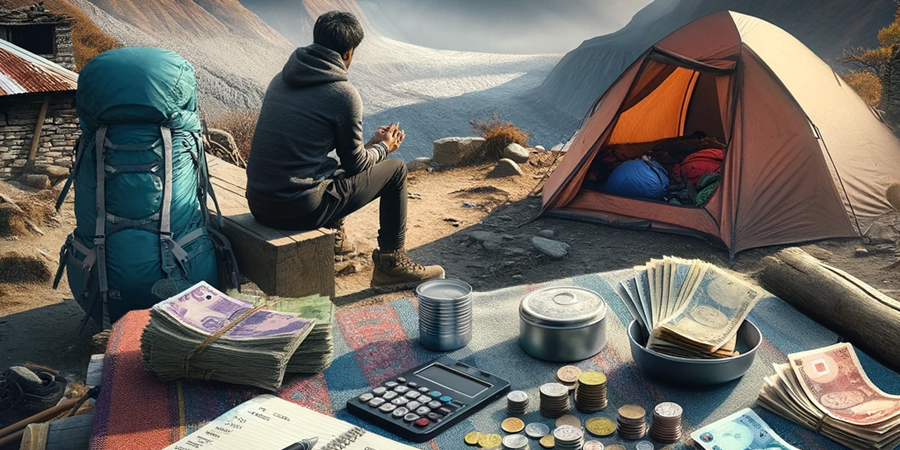
Practical Financial Tips for Trekkers
- Smaller Denominations: Carry smaller notes for convenience in transactions and to avoid issues with change.
- Secure Your Money: Keep your cash and cards in a secure money belt or pouch to prevent loss or theft.
- Emergency Cash: Maintain a separate emergency fund apart from your central budget.
- Guidance from Your Trekking Guide: Consult with your guide regarding the amount of cash you’ll need for different segments of the trek.
- Inclusive of Additional Fees: Factor in ATM transaction fees and any charges from your home bank when budgeting.
Effective money management is vital to a seamless experience on the Annapurna Base Camp Trek.
By preparing financially and being aware of the monetary logistics, trekkers can enjoy stunning landscapes and rich cultural experiences without financial worries.
Top 10 Frequently Asked Questions (FAQs) about the Annapurna Base Camp Trek
The best seasons for the Annapurna Base Camp Trek are Spring (March to May) and Autumn (September to November). Winter and Monsoon are doable but come with challenges, such as cold temperatures or heavy rain.
You’ll need an Annapurna Conservation Area Permit (ACAP) and a TIMS card. These permits can be issued in Kathmandu or, in some cases, in Pokhara.
The trek from Pokhara takes around ten days, while from Kathmandu, it can be completed in approximately 12 days, including travel time.
Annapurna Base Camp is situated at an elevation of 4,130 meters above sea level.
The trek is considered moderate in difficulty. While it does not require technical skills, you should be physically fit and accustomed to high-altitude trekking.
Our Annapurna Base Camp Package is an all-inclusive offering that covers permits, accommodations, meals, and guide services, making it a hassle-free option for trekkers.
ATMs are available in major cities like Kathmandu and Pokhara but are scarce along the Annapurna base camp trek route. Plan your finances carefully.
Teahouses along the trek offer various food options, from traditional Nepali meals to some international dishes. However, as you go higher, the menu options may become limited.
We recommend not drinking tap water. Filtered water, boiled water, or bottled water are the safer options for drinking.
Most Annapurna base camp trek teahouses offer electricity for charging electronic devices, and some even provide Wi-Fi services, though the connection may be unreliable as you ascend.
Reviews on Annapurna Base Camp Trek
Be first to post a review in this trip.



